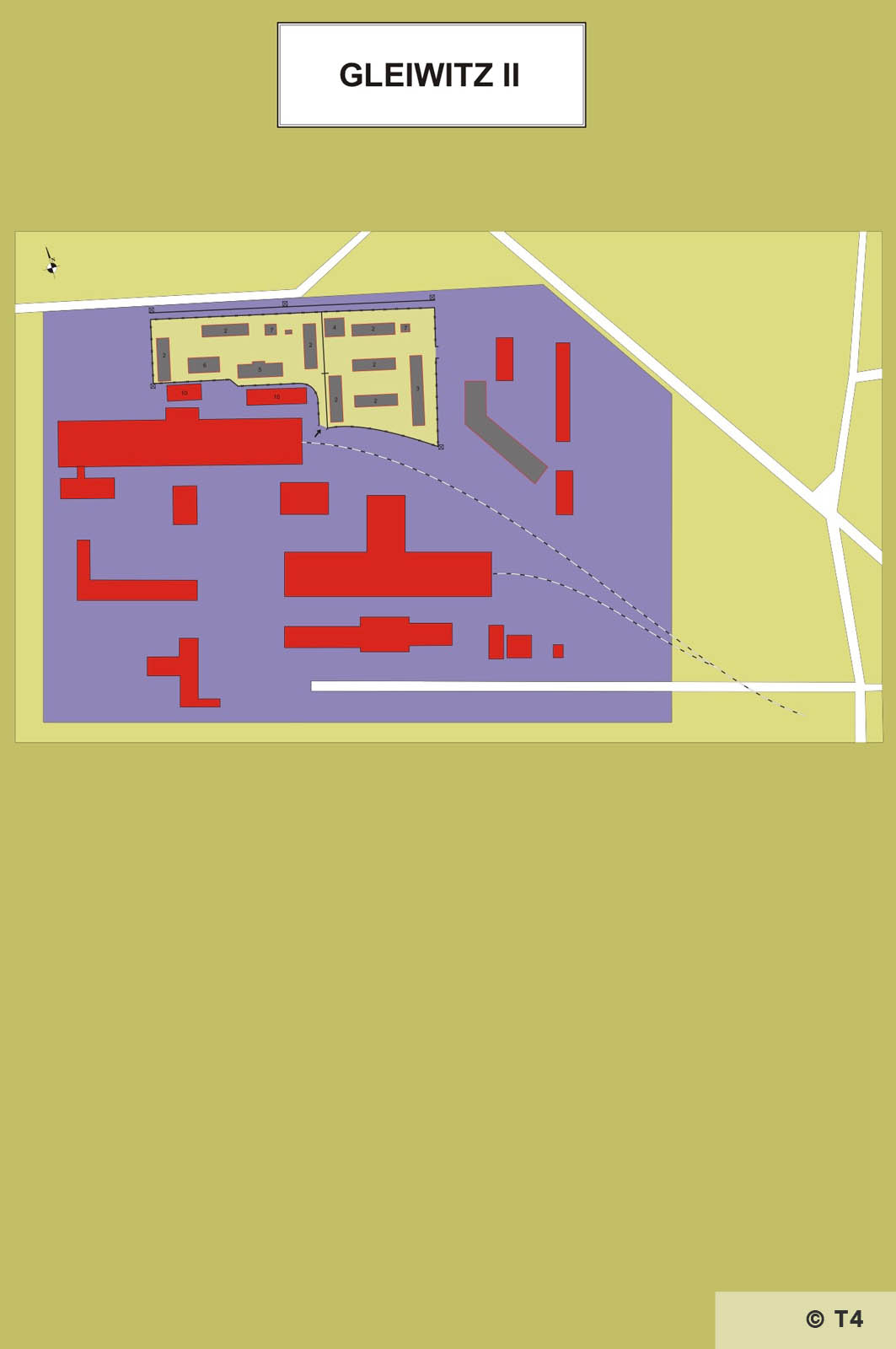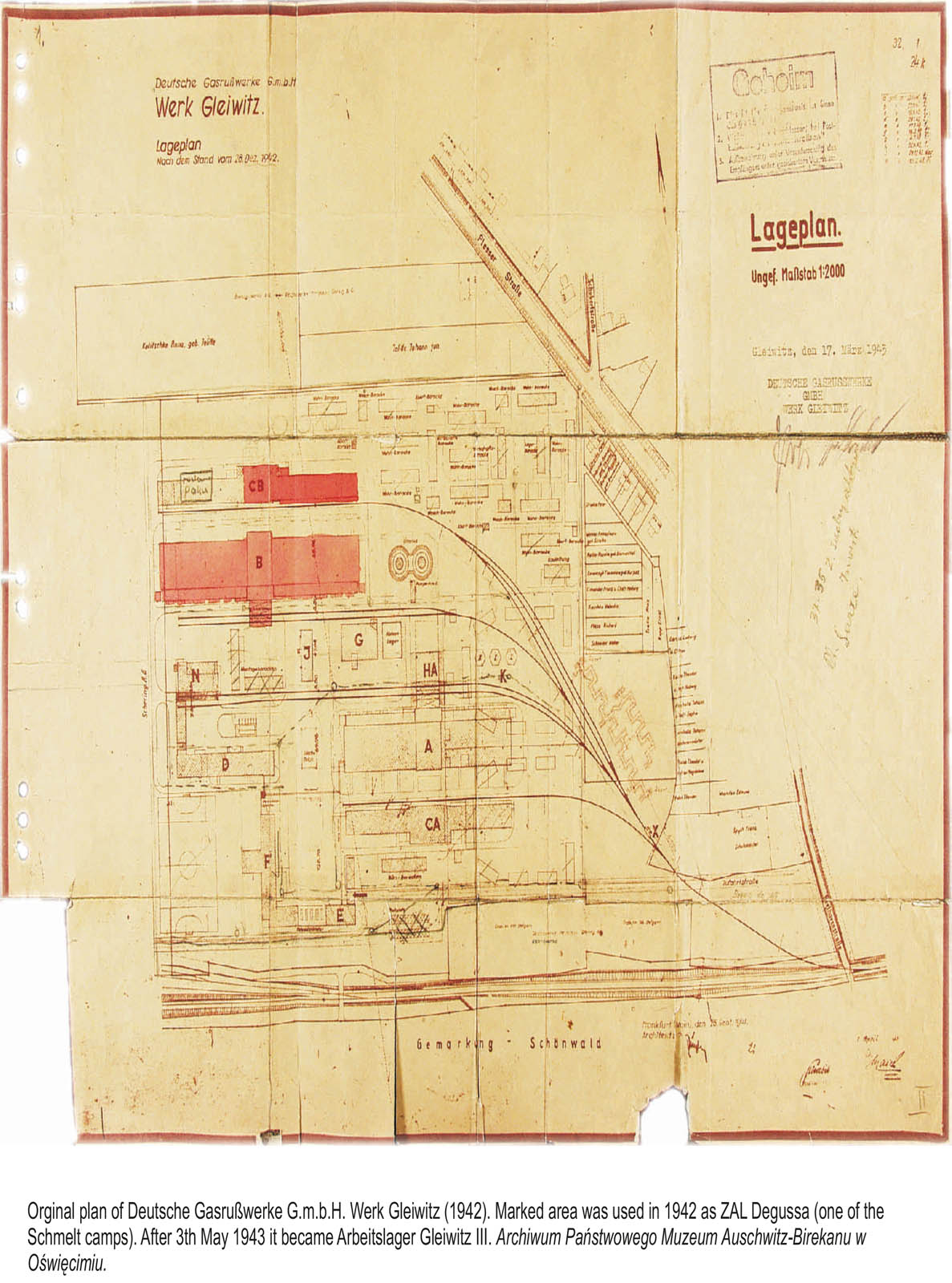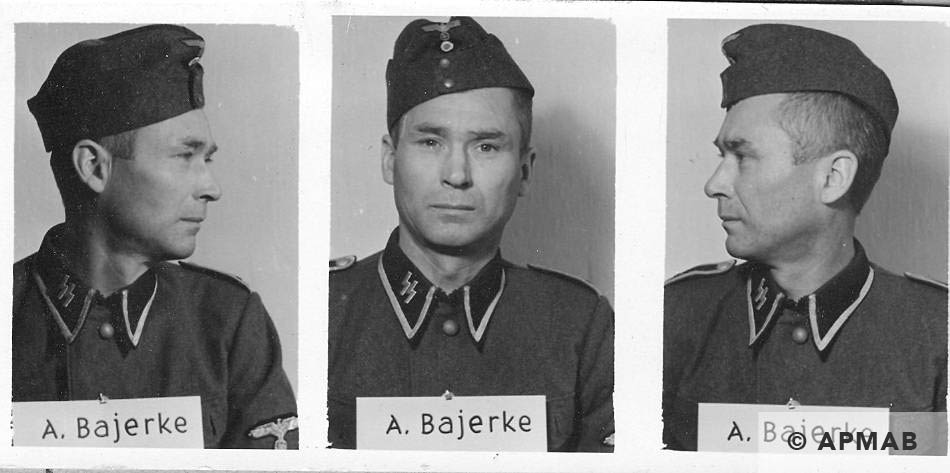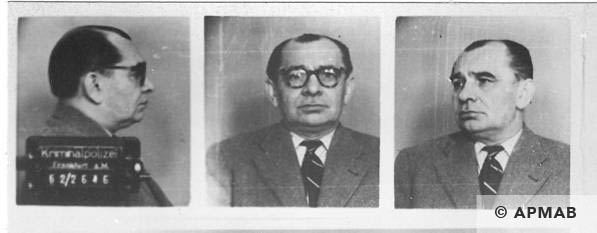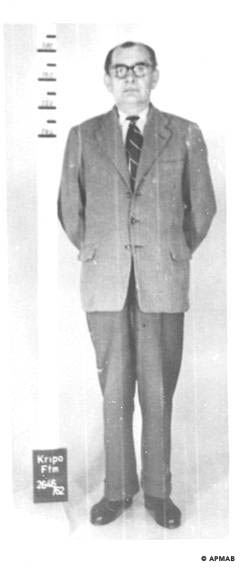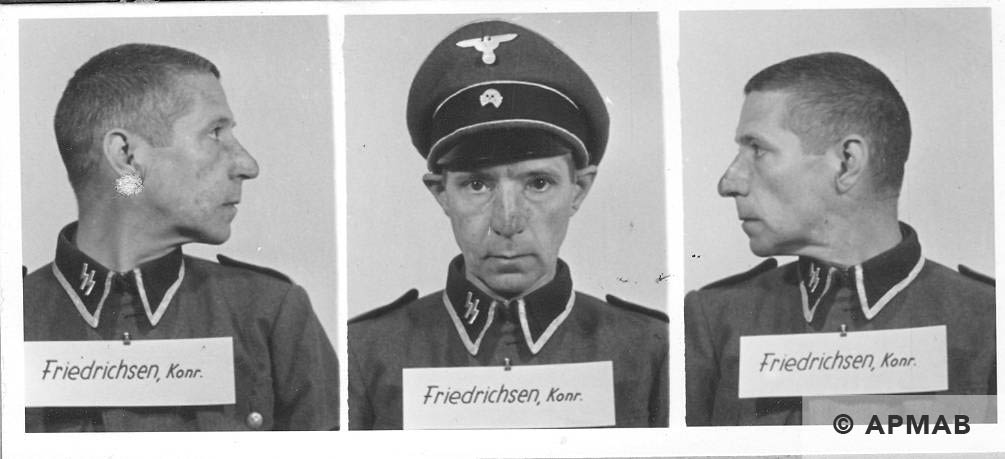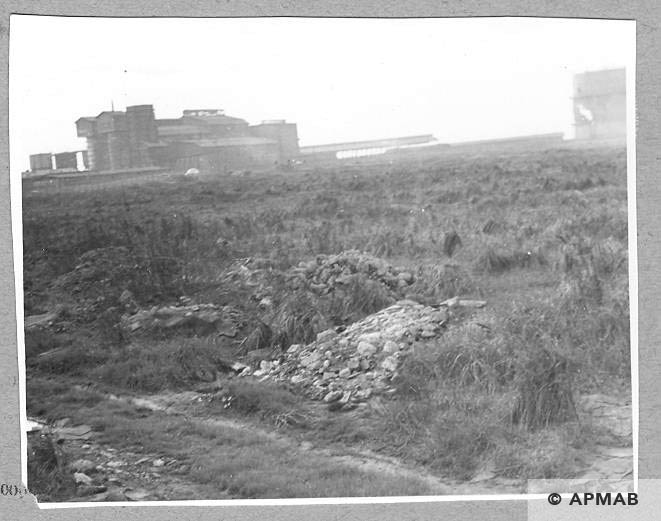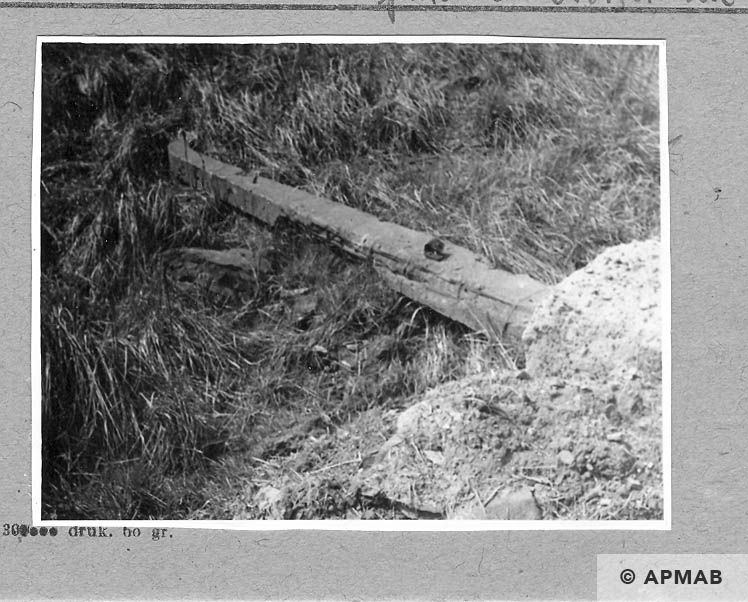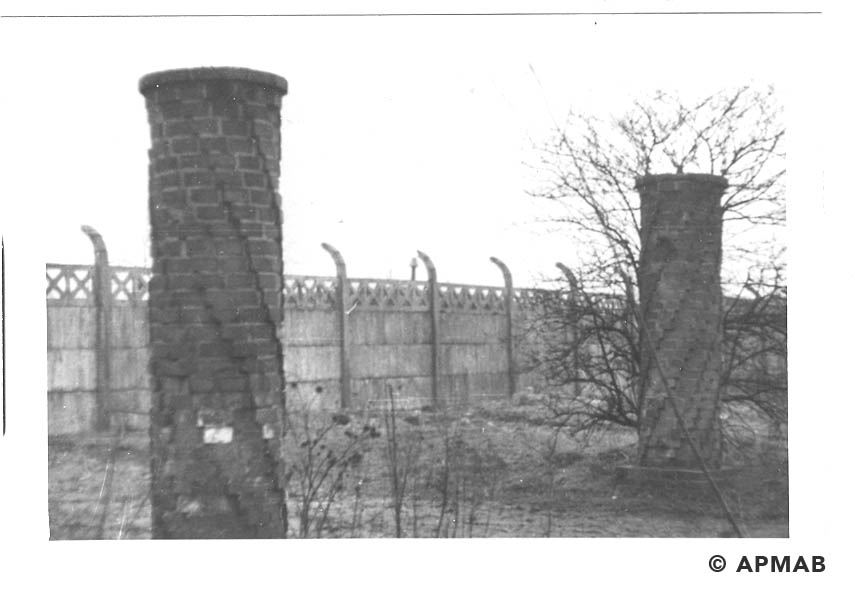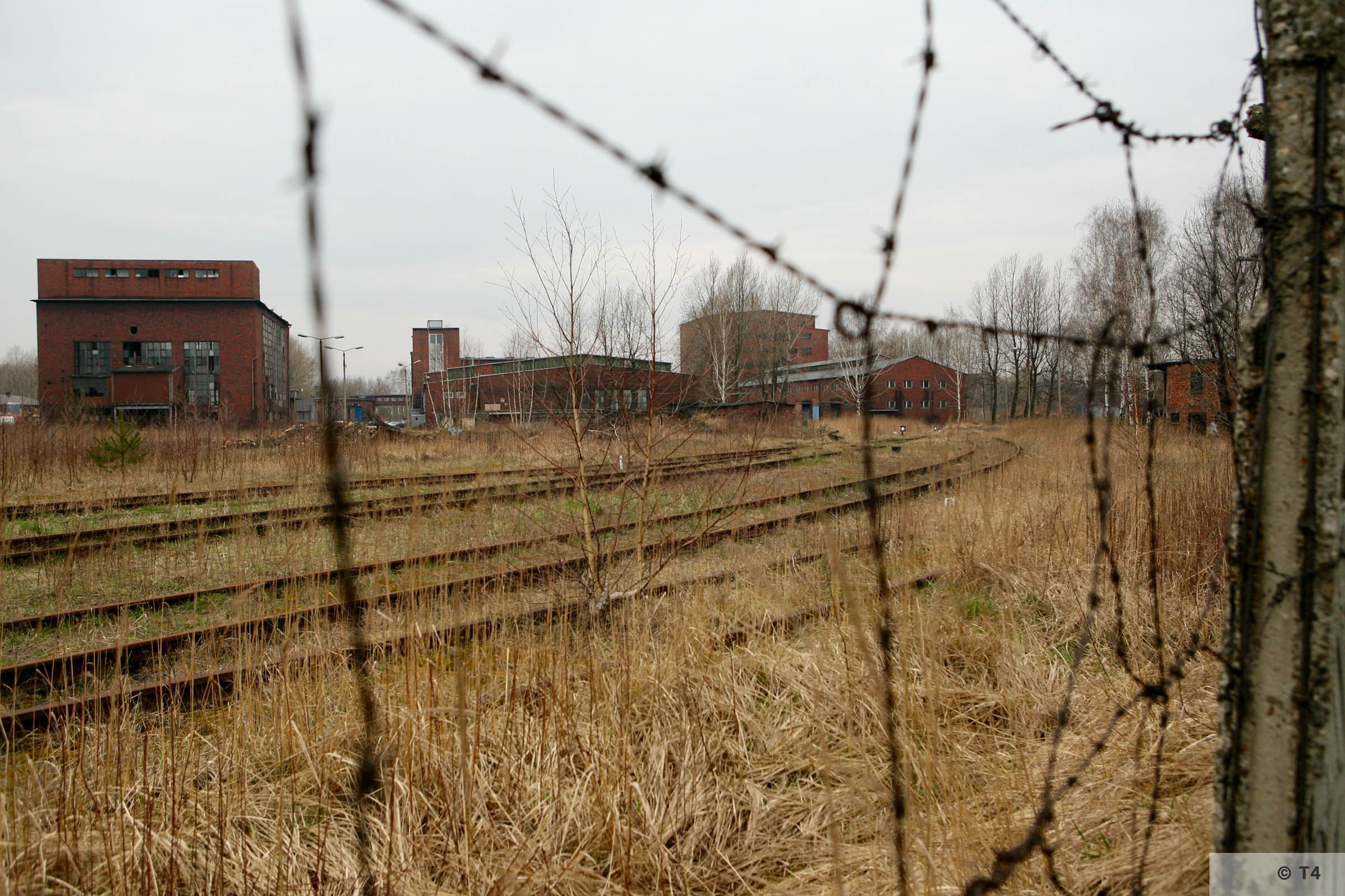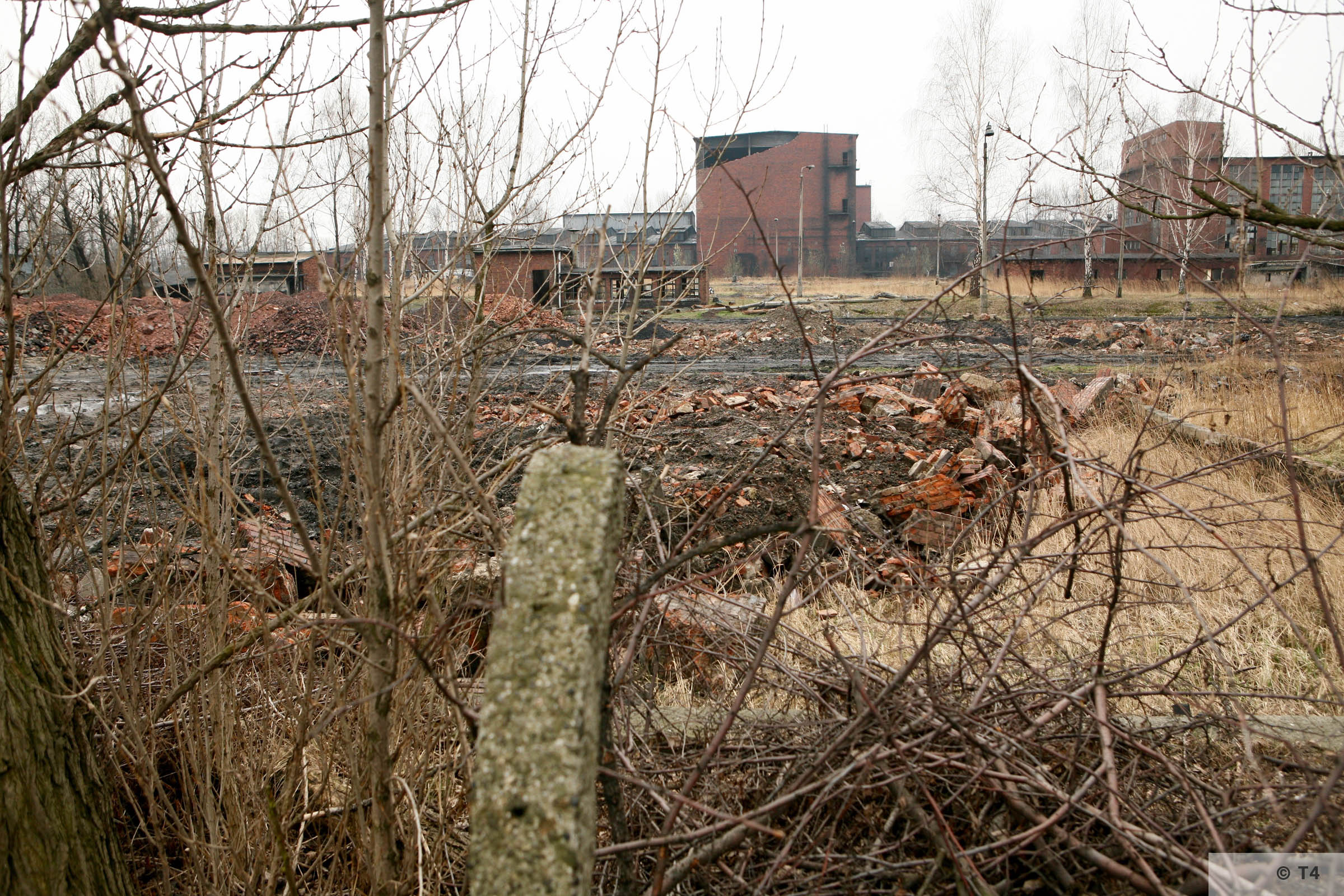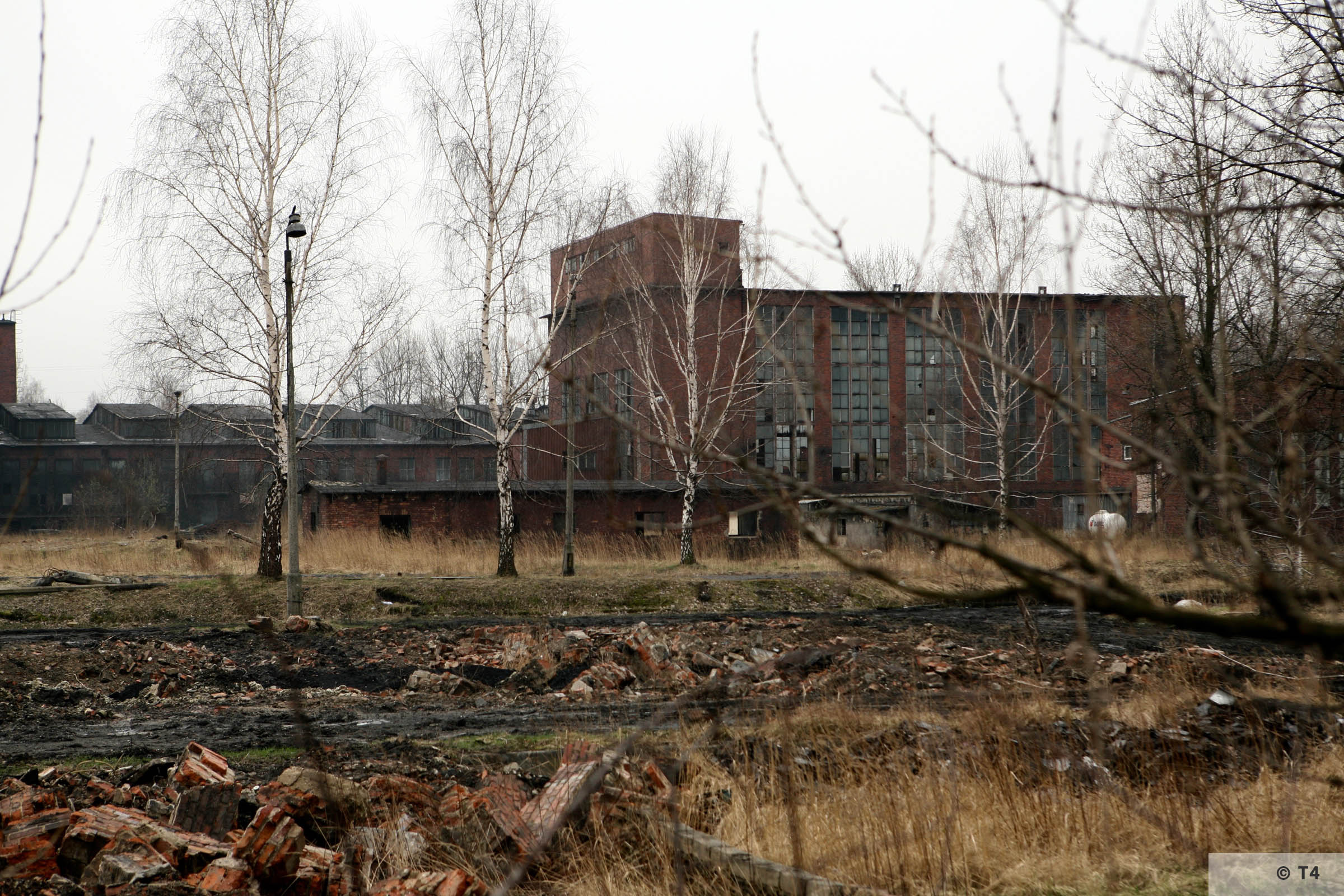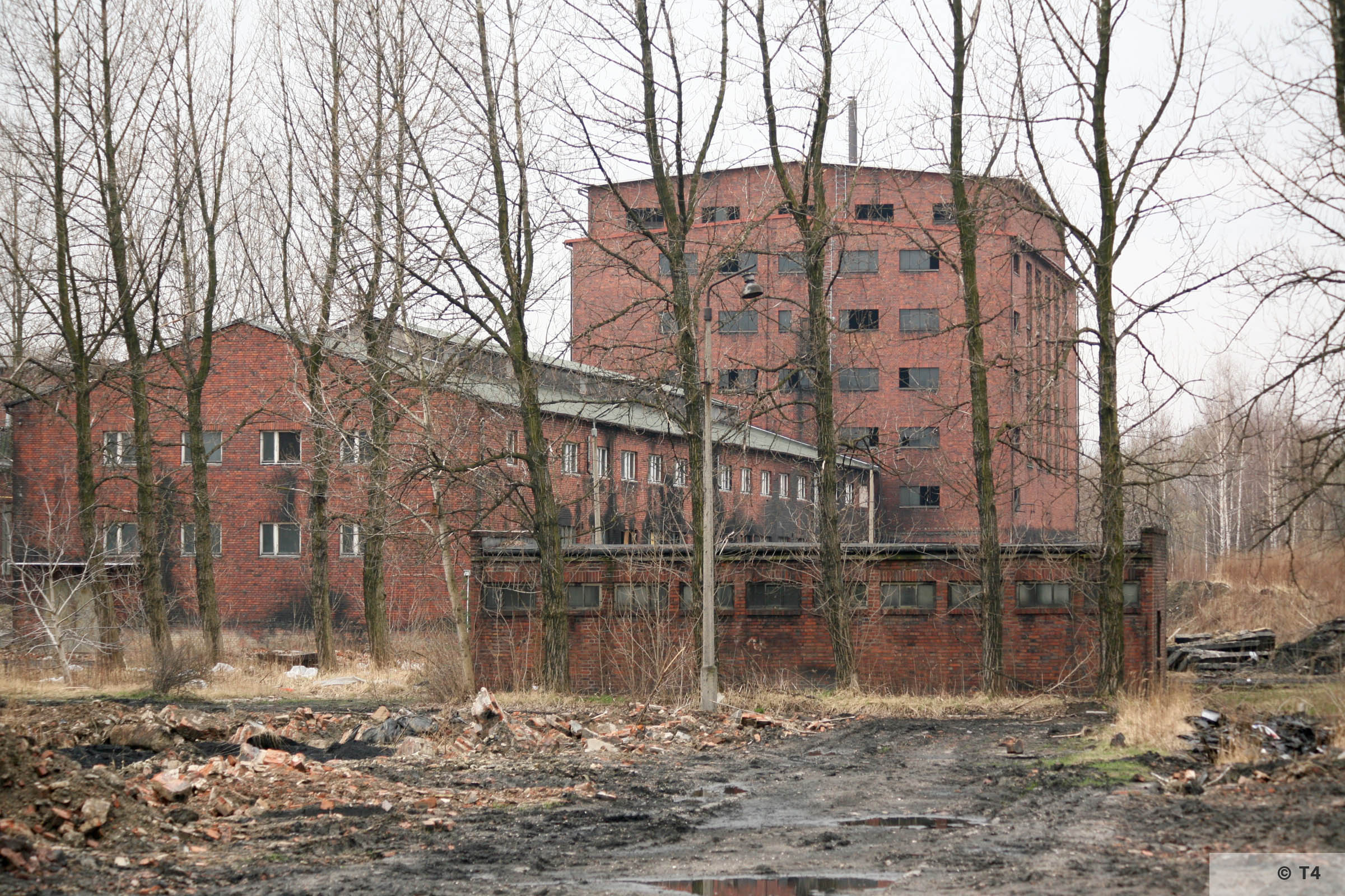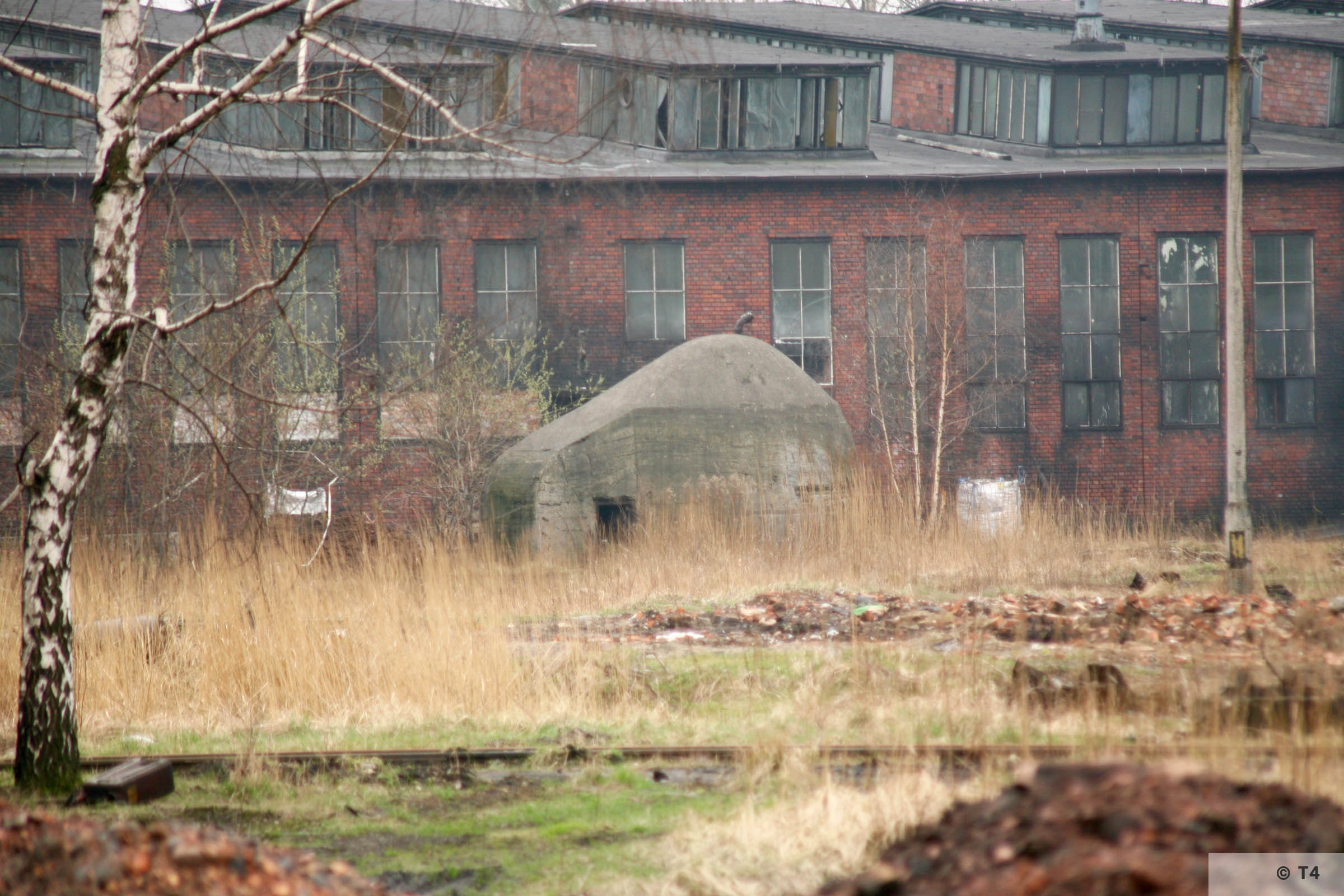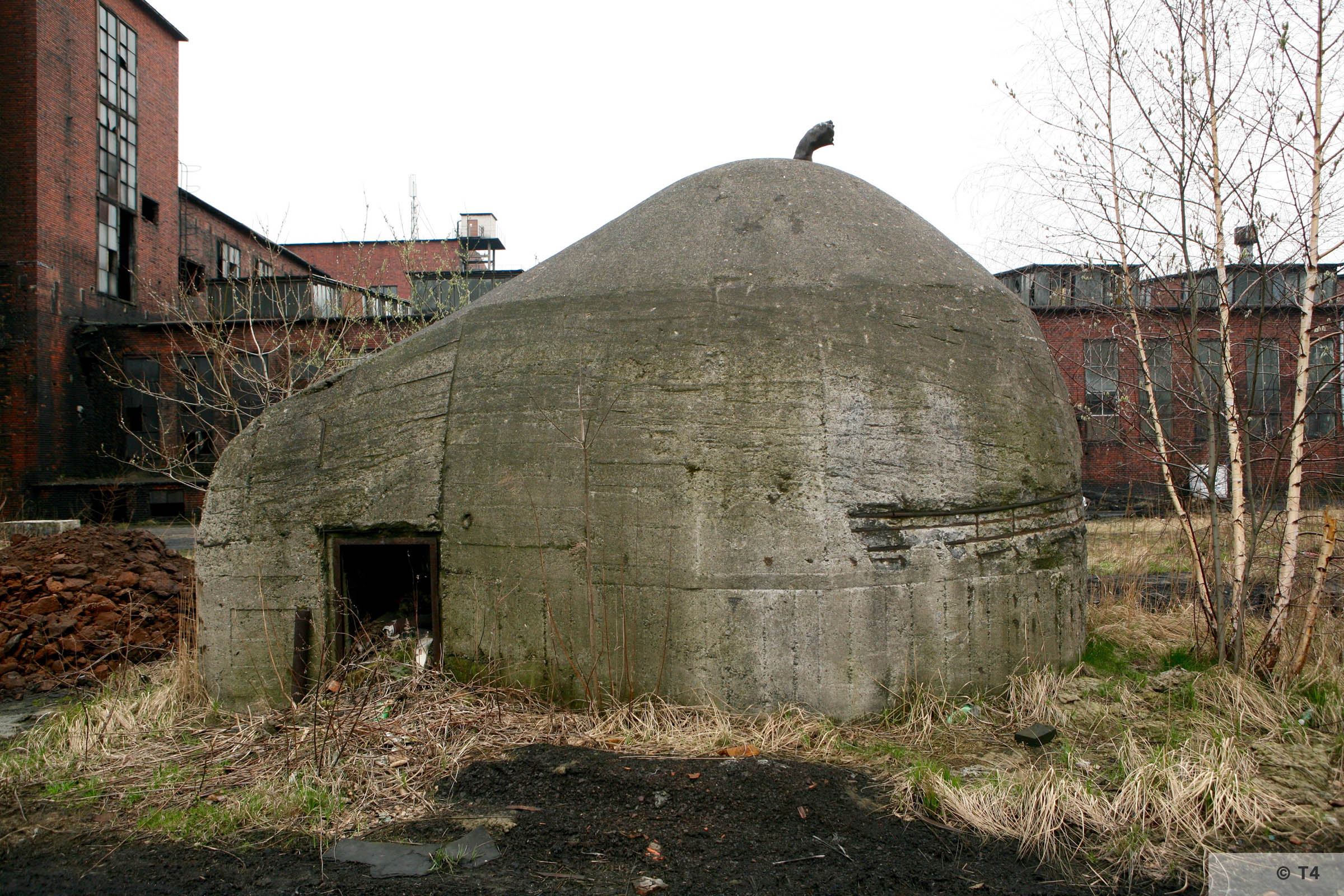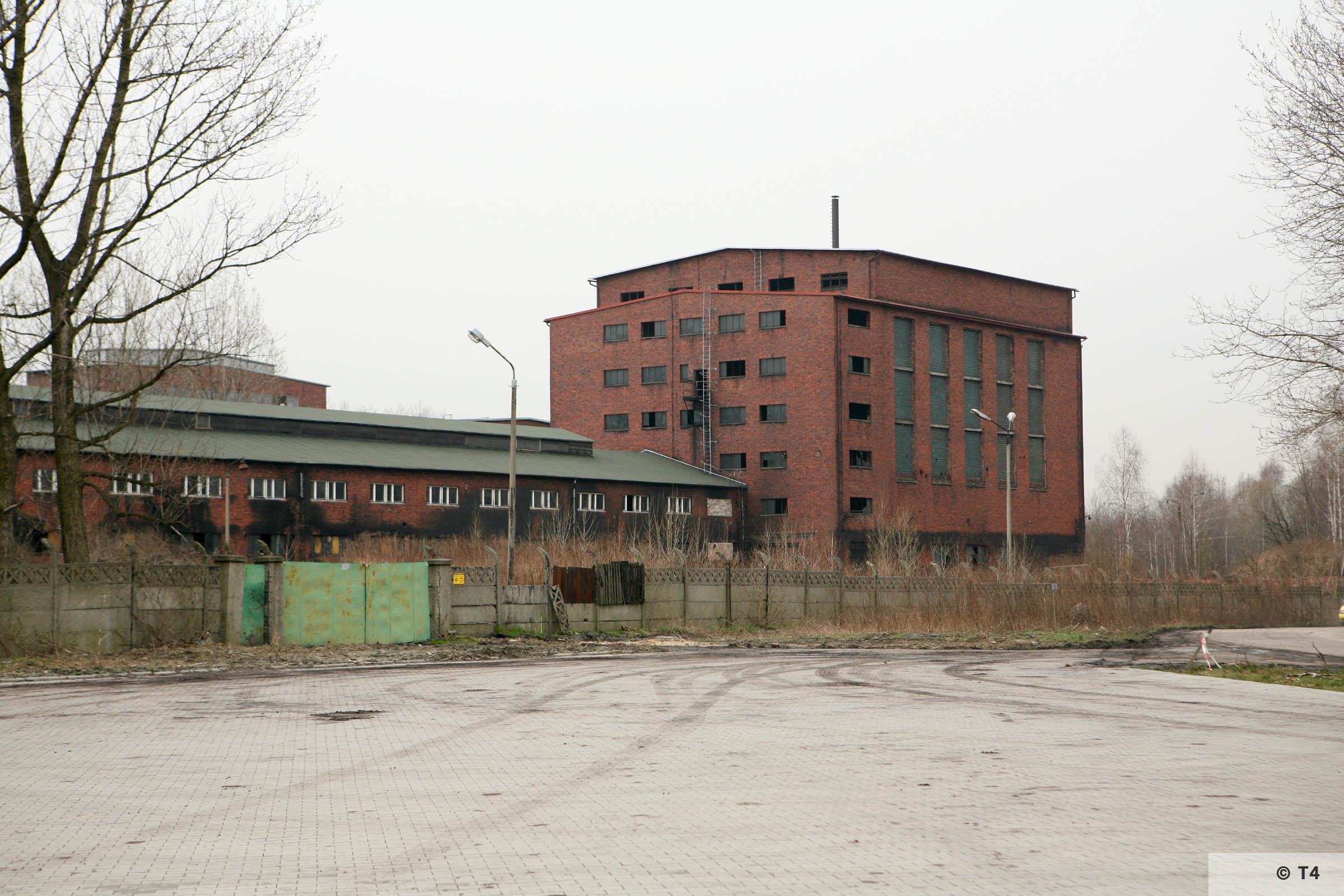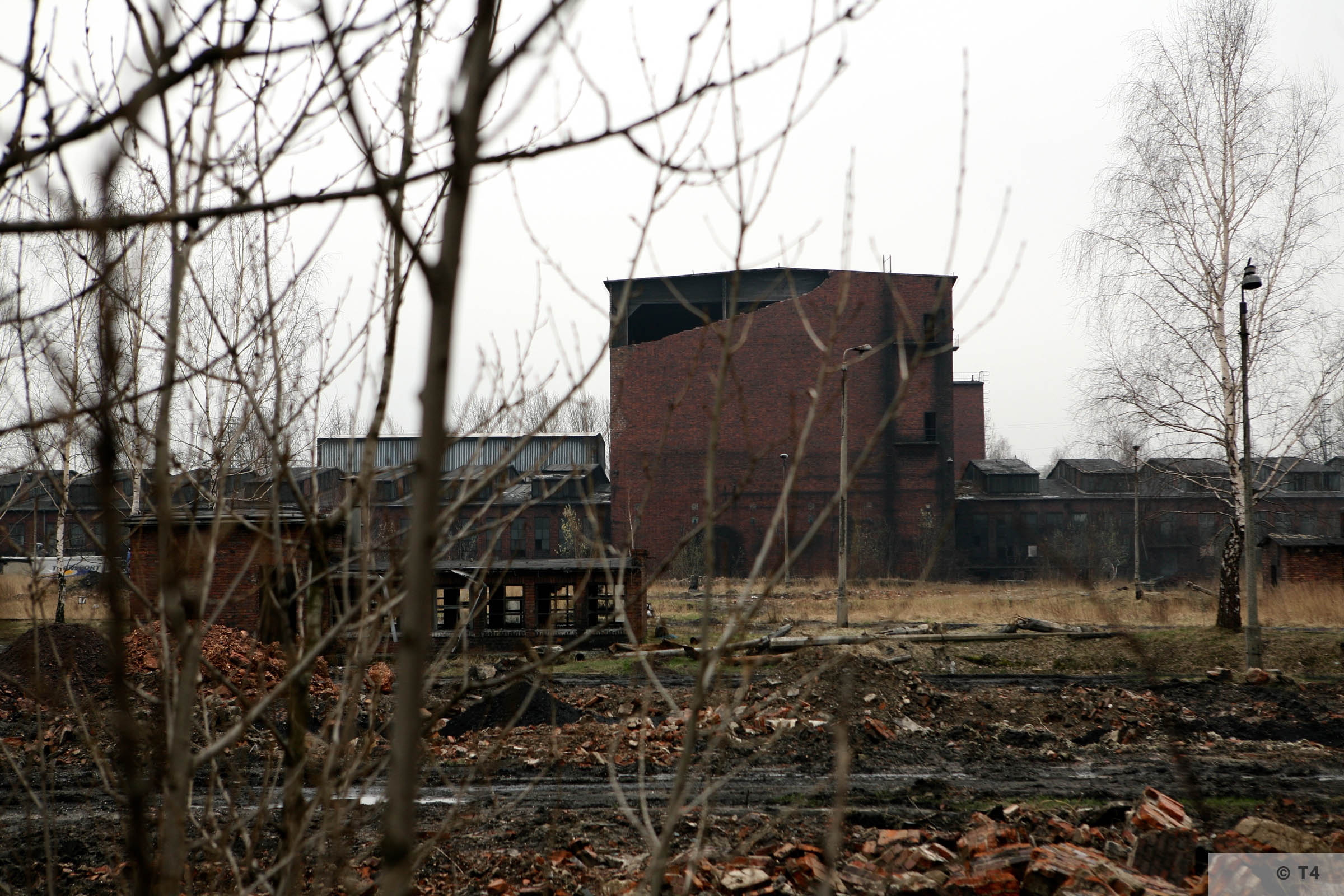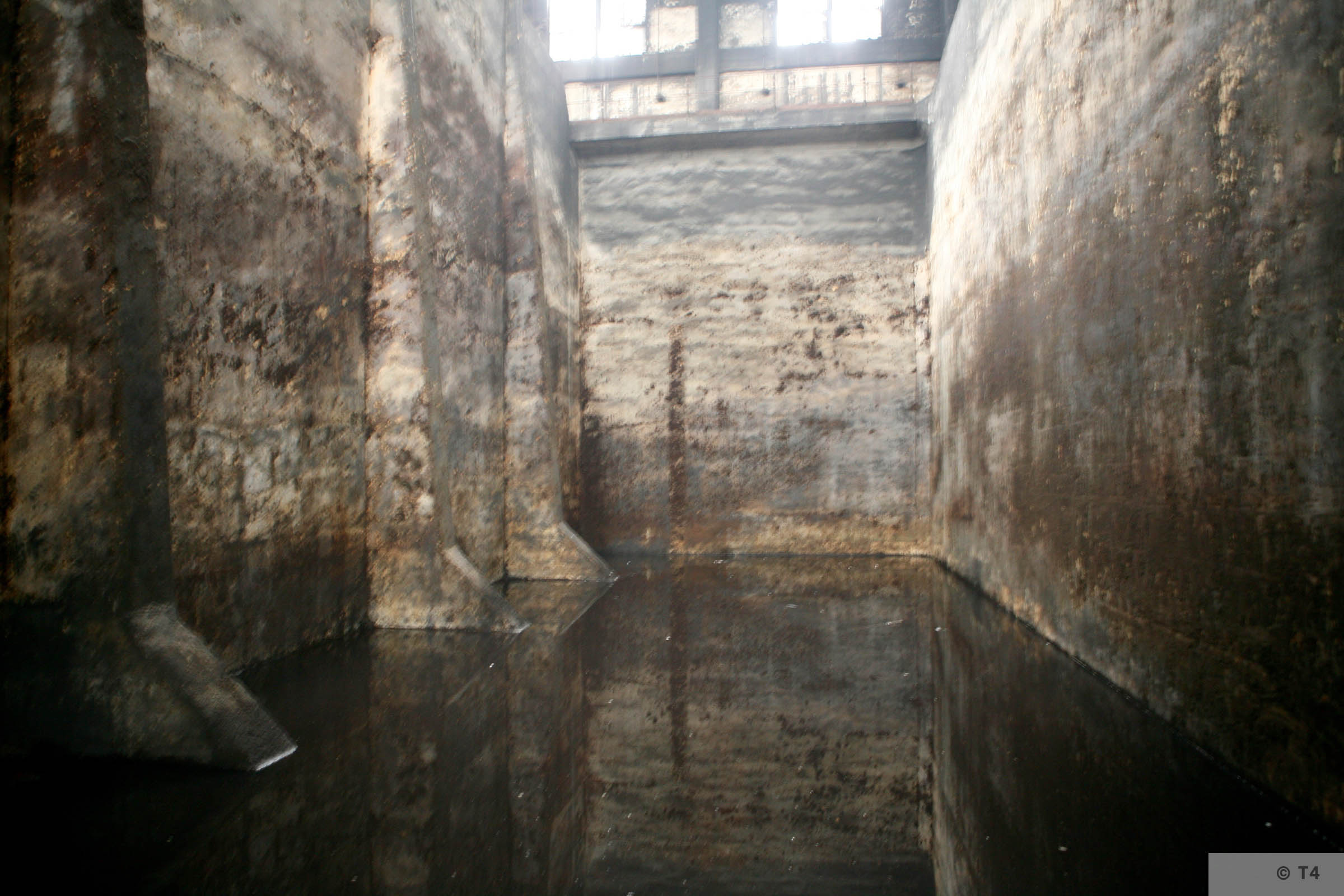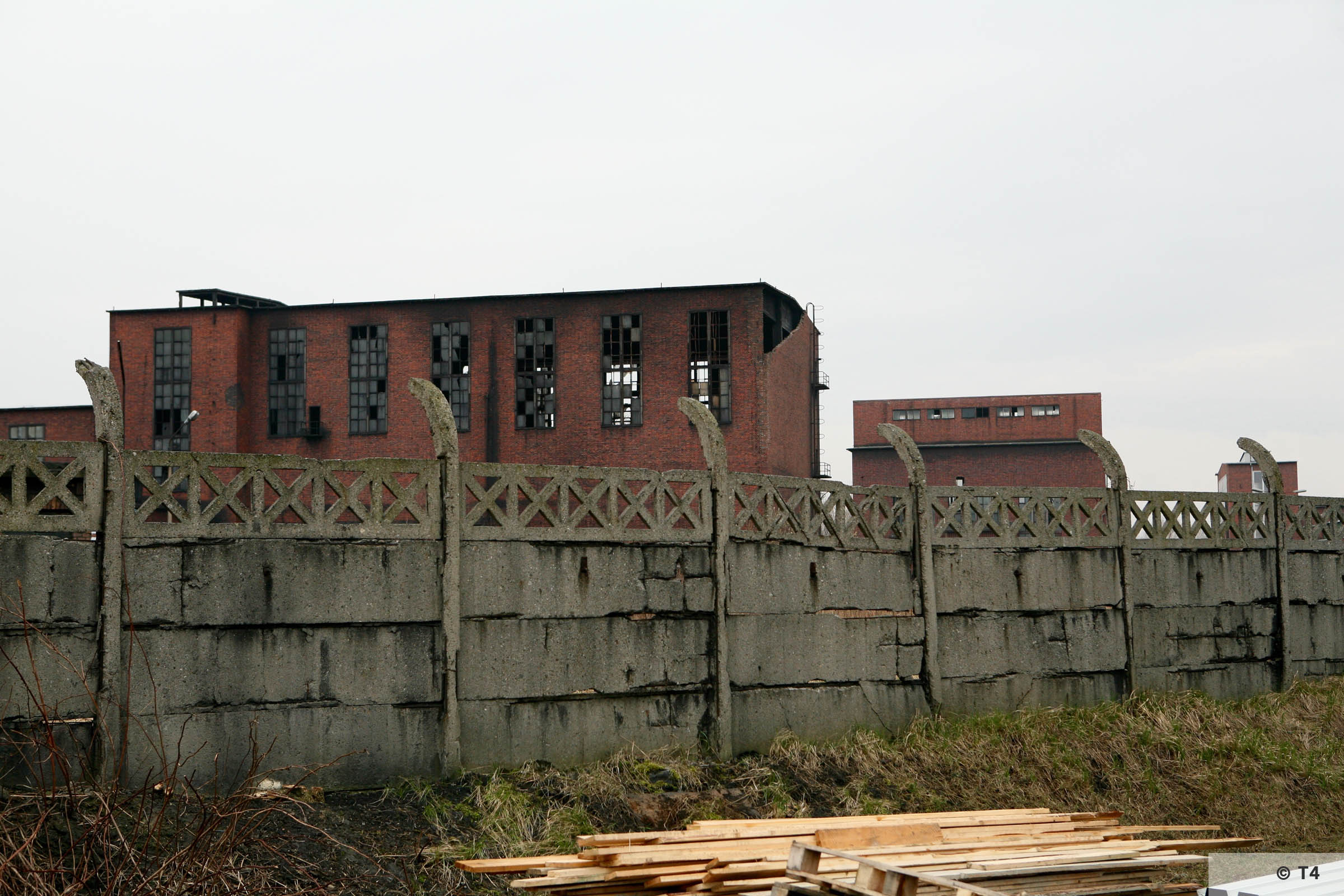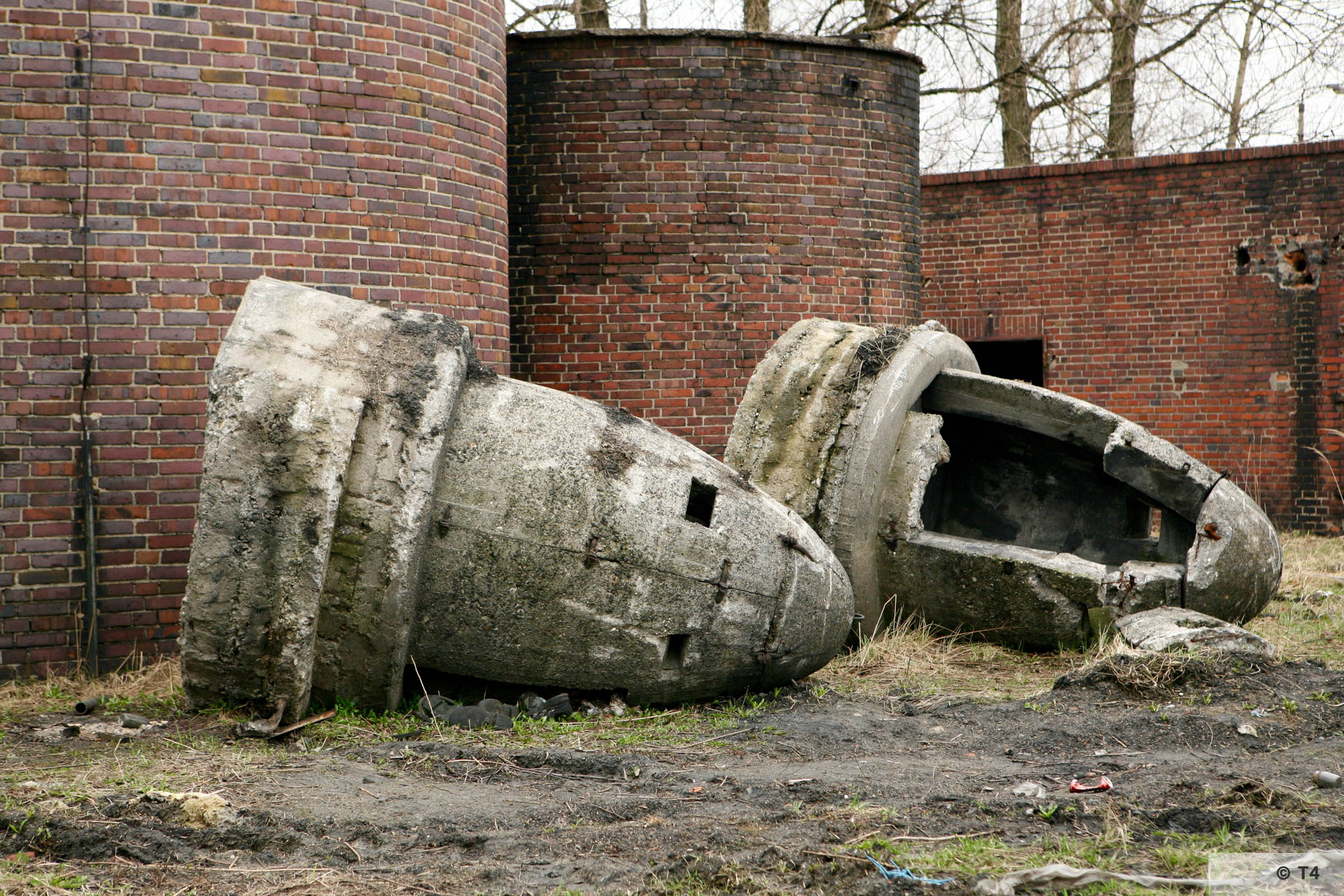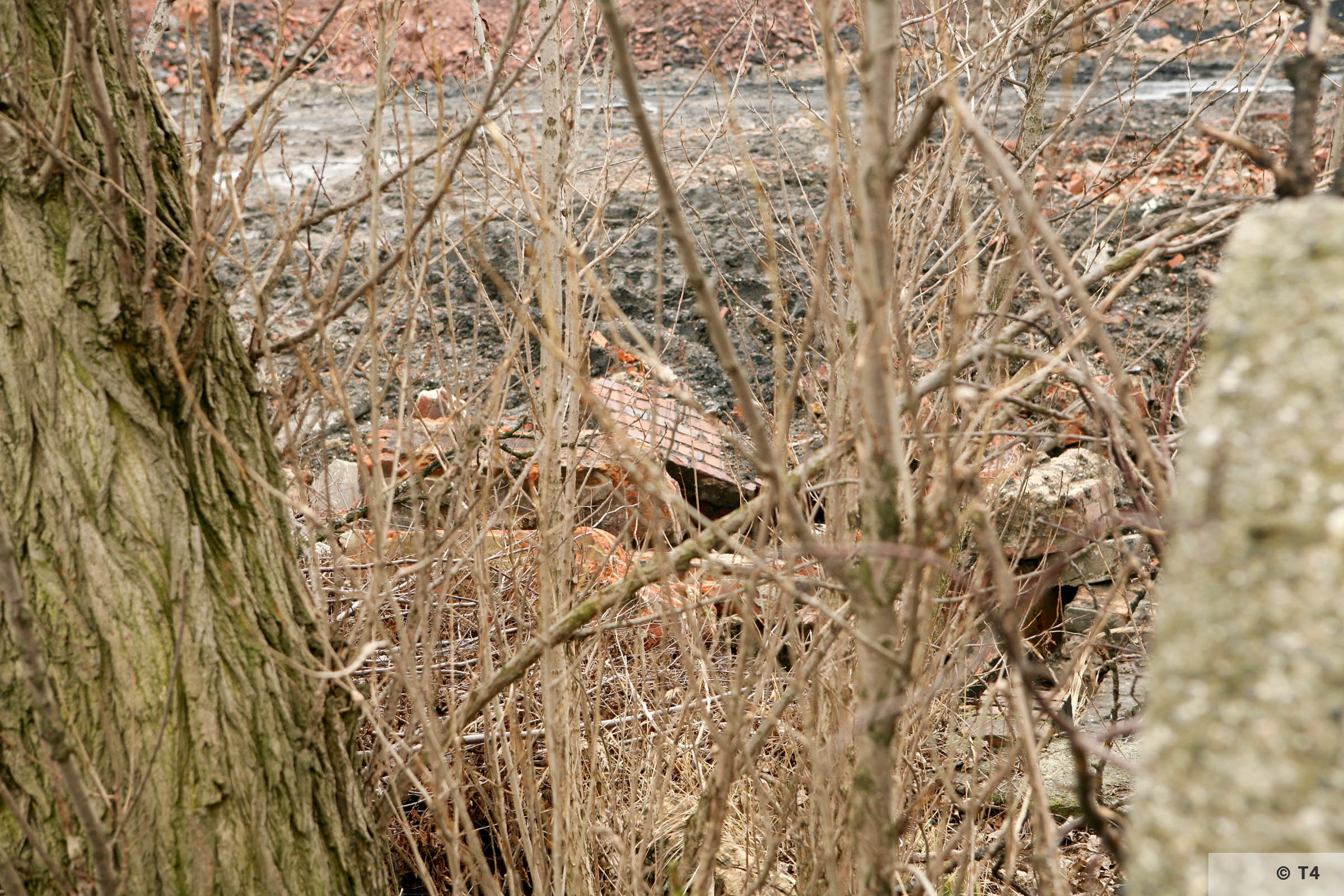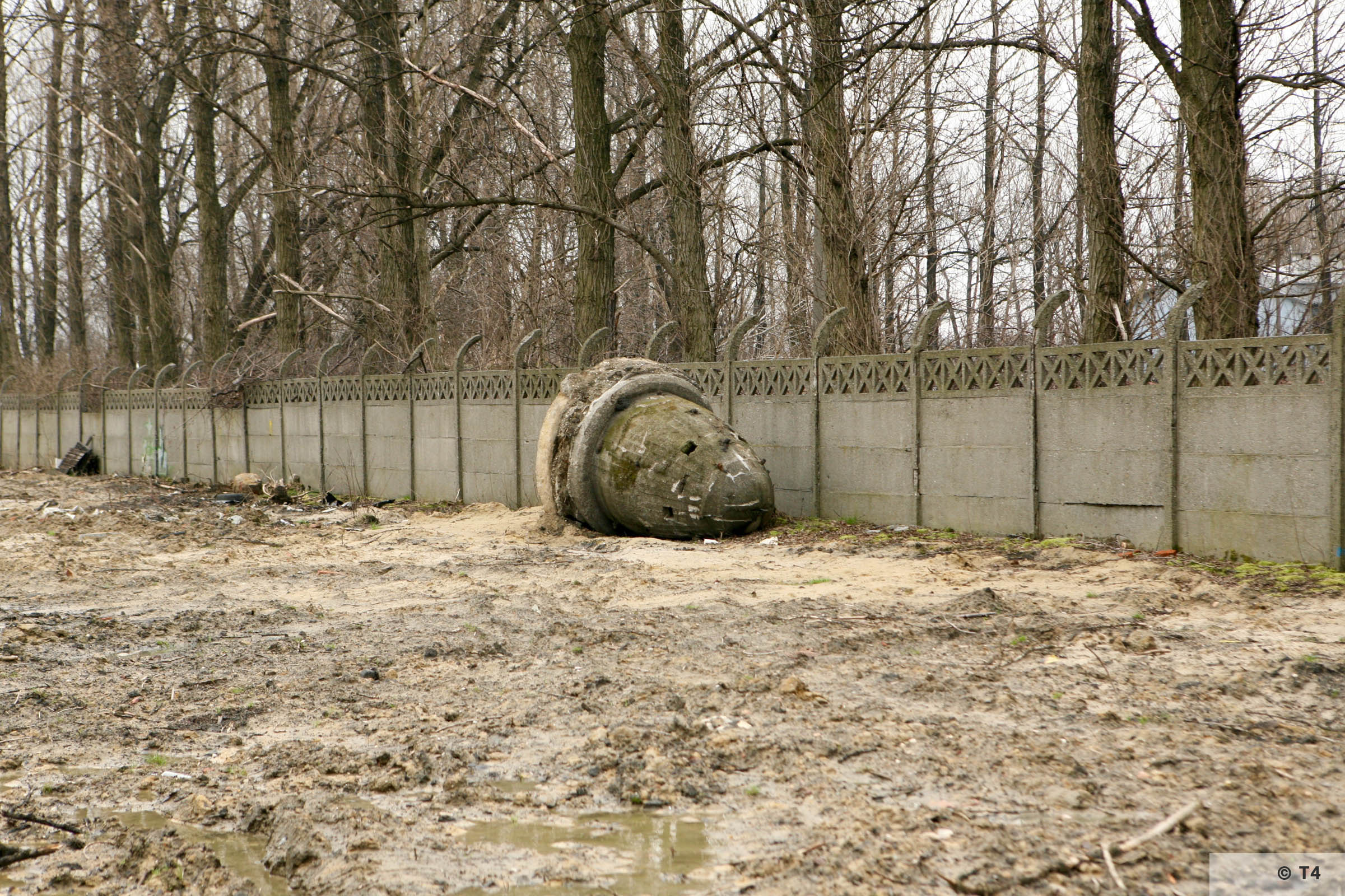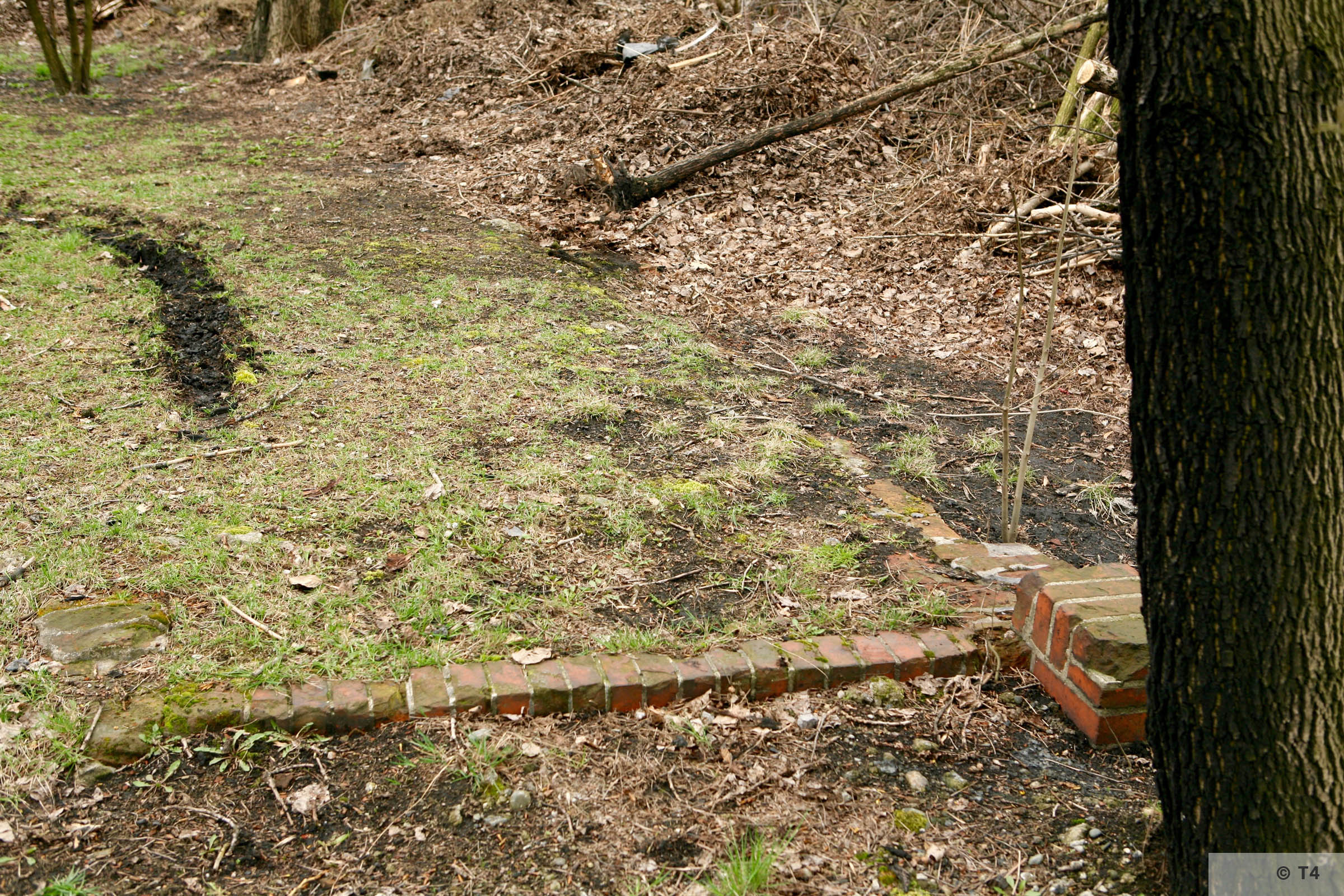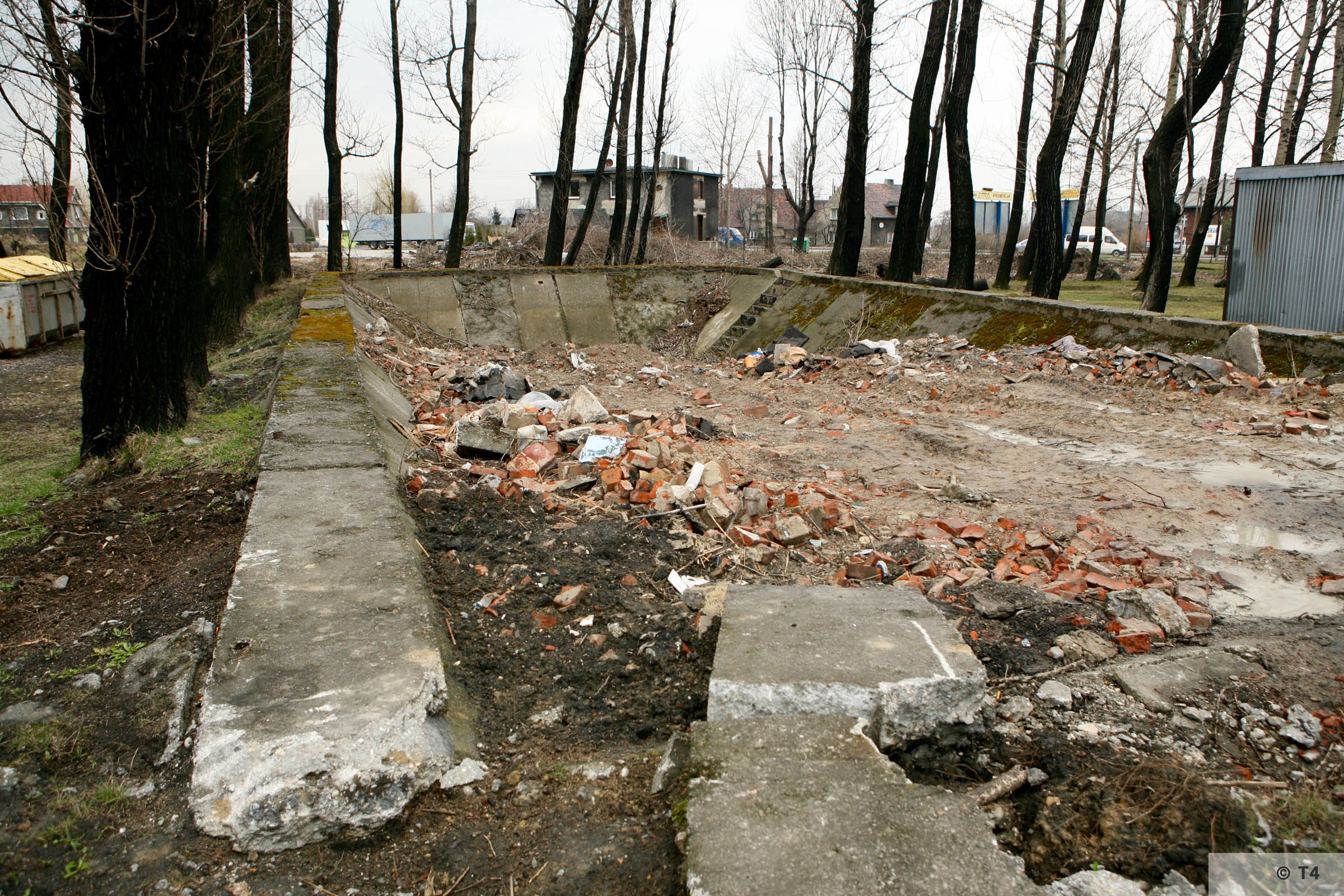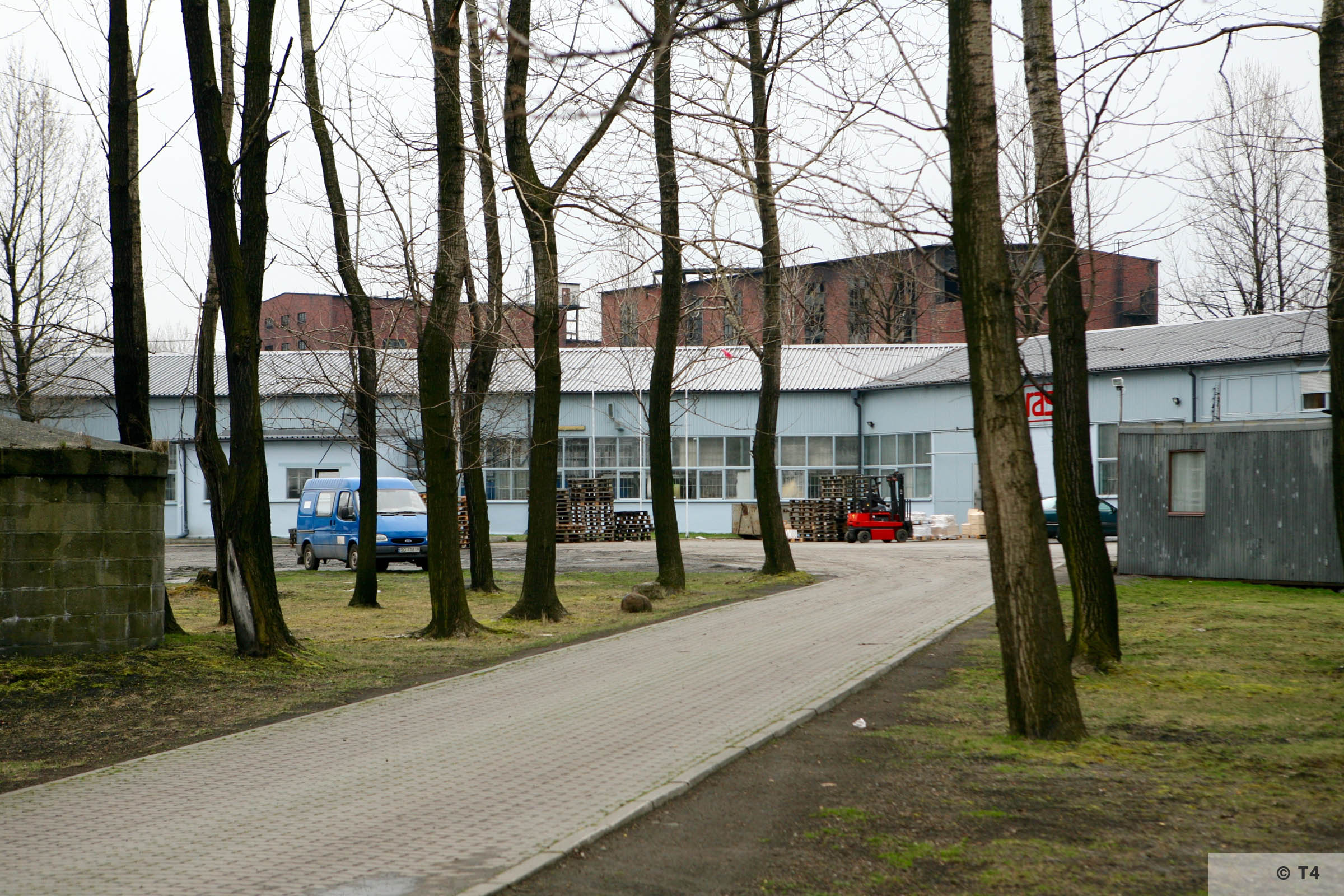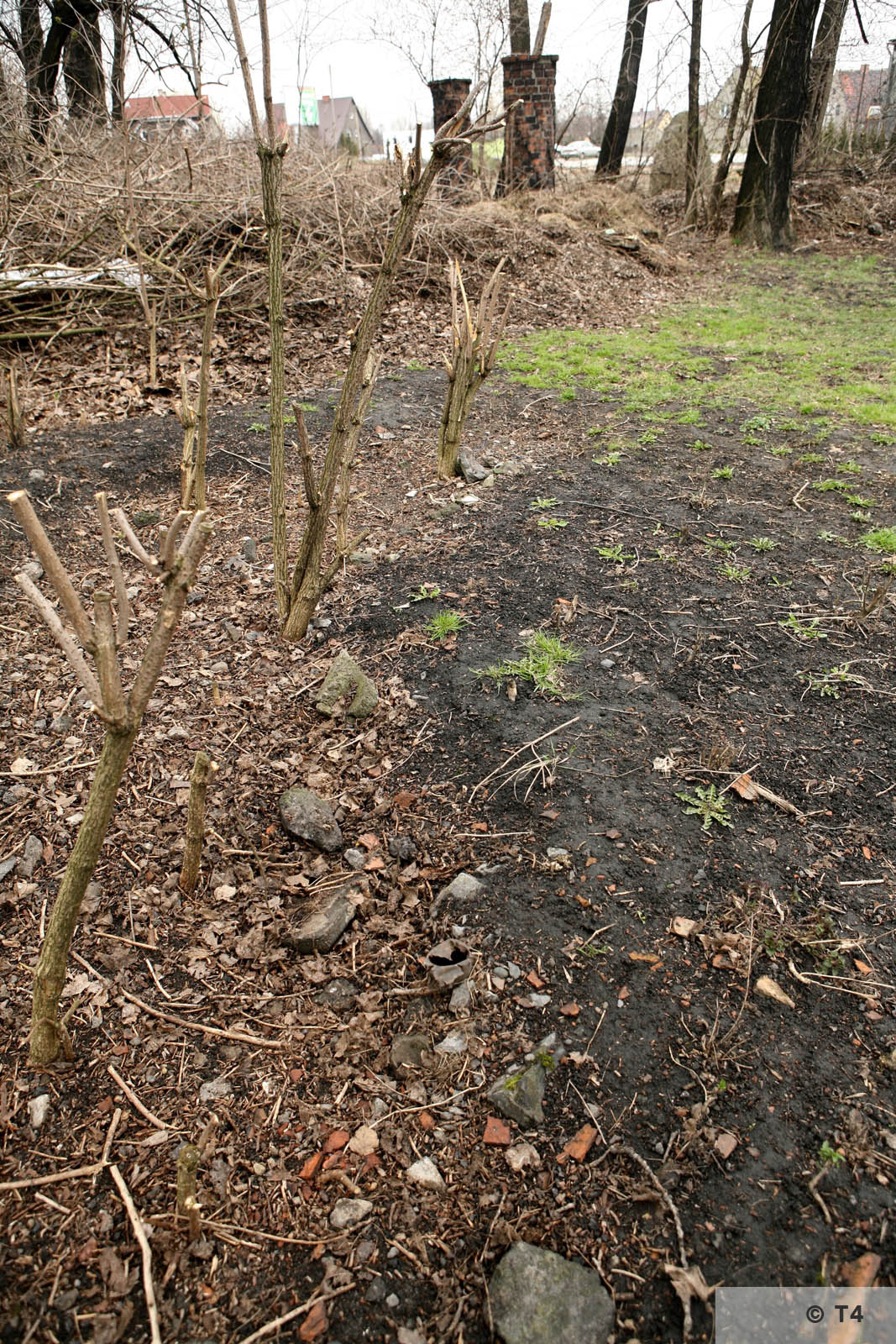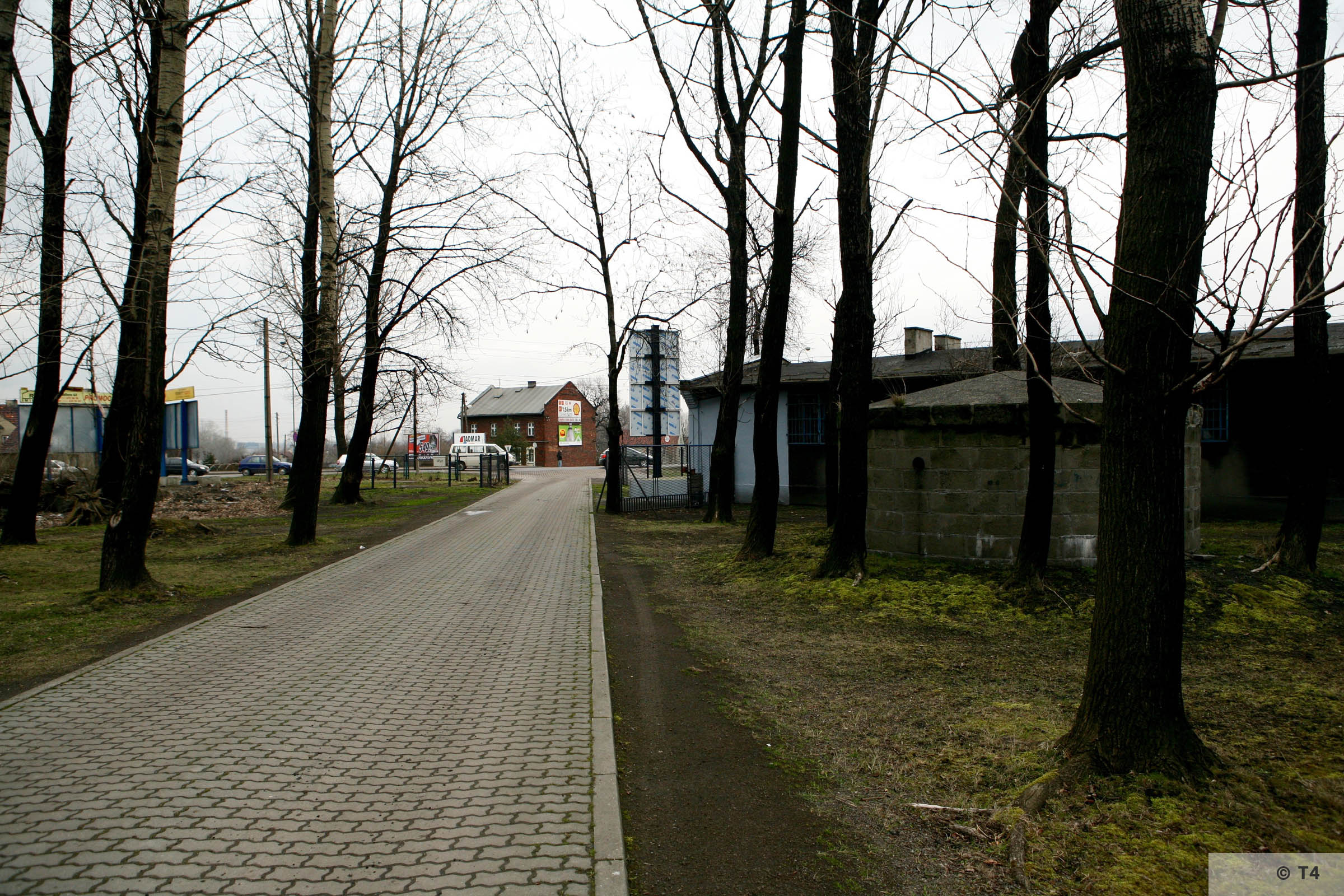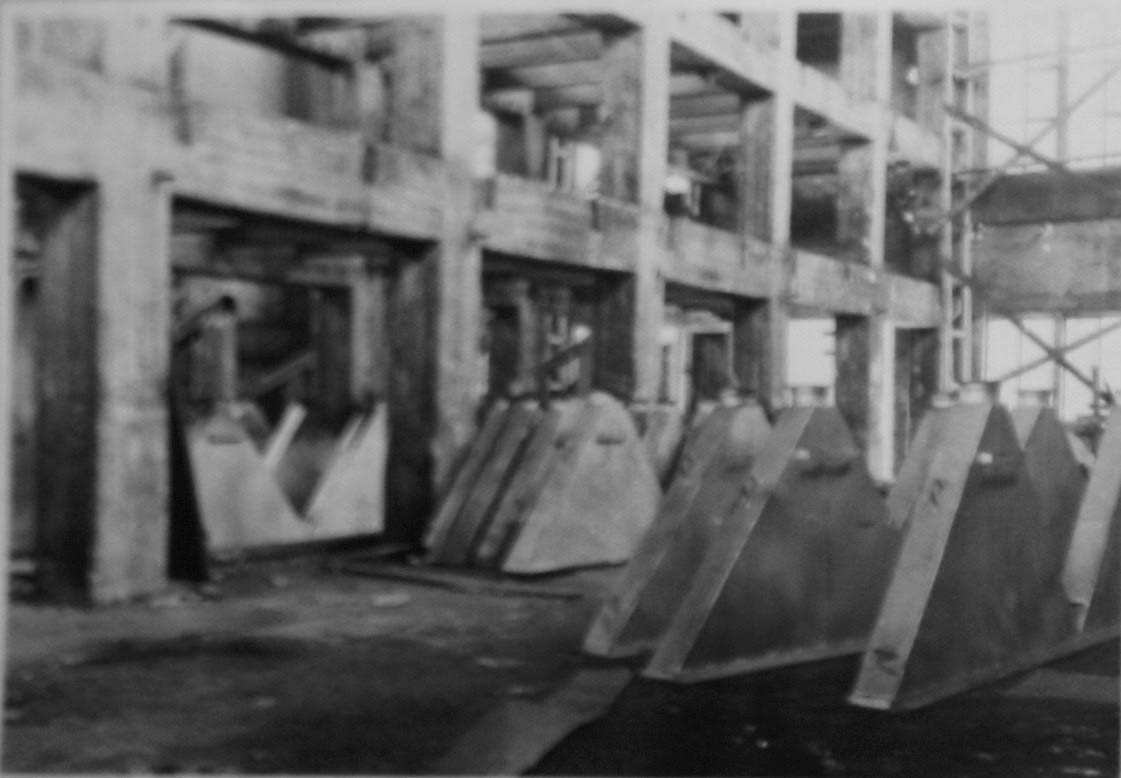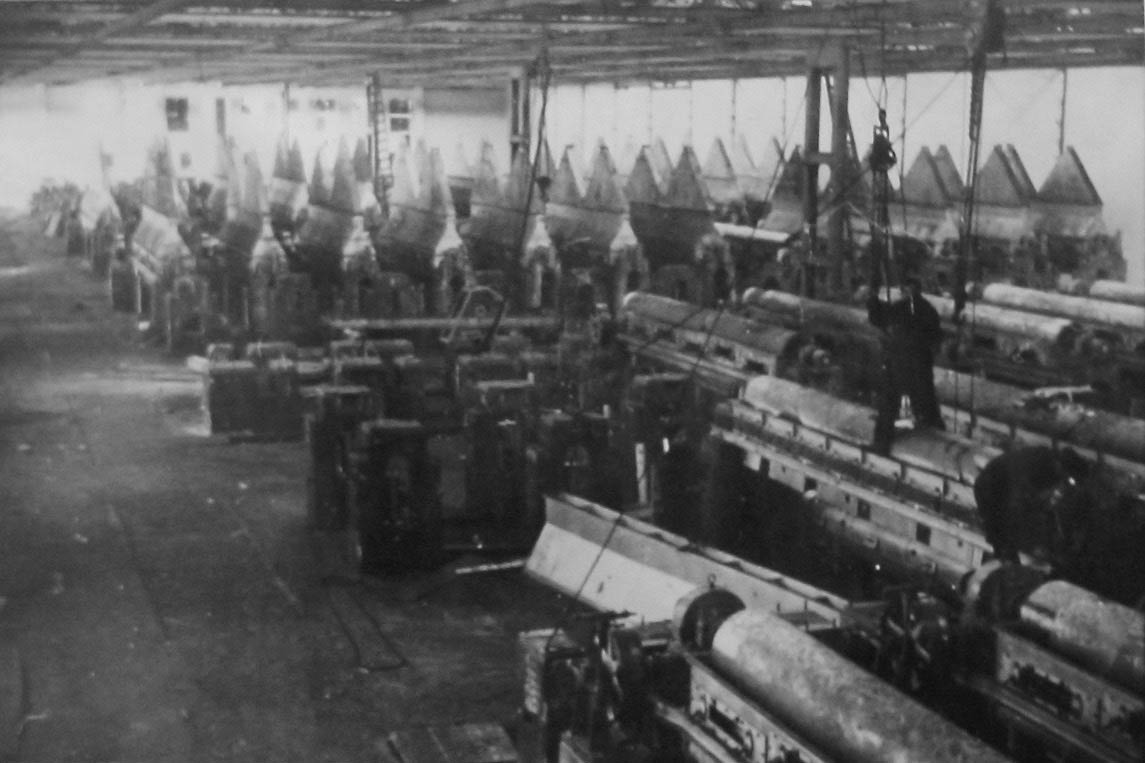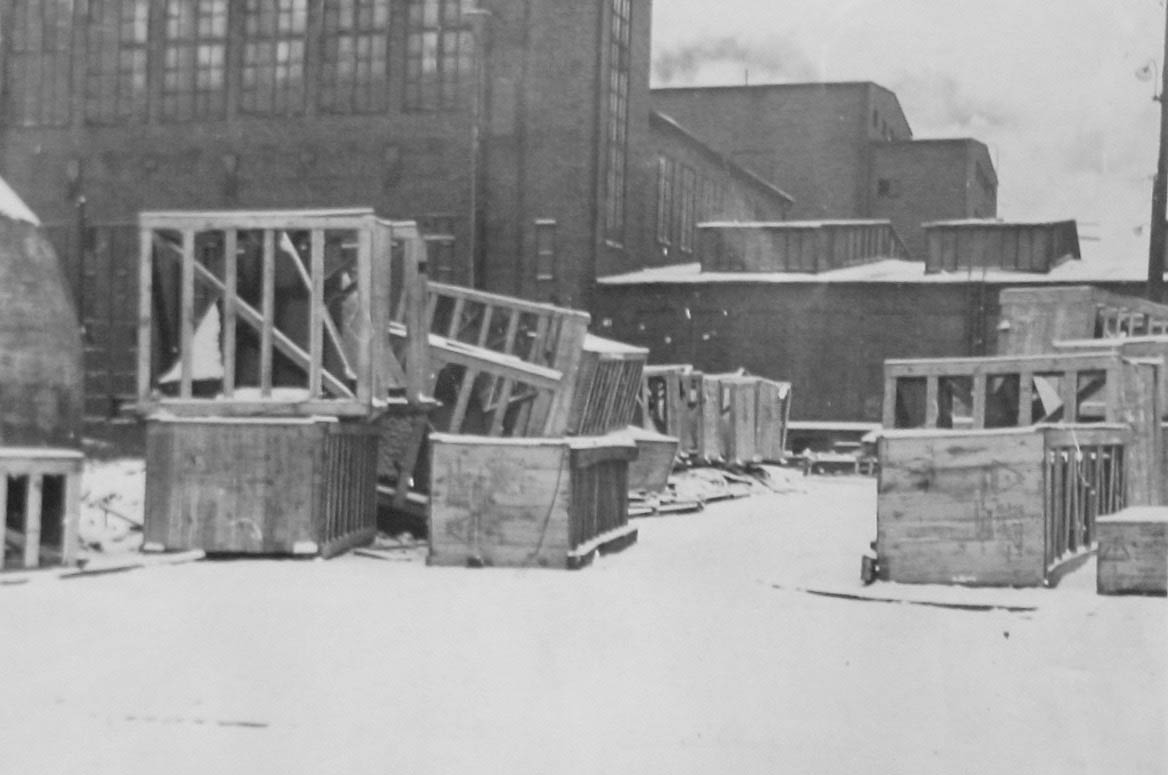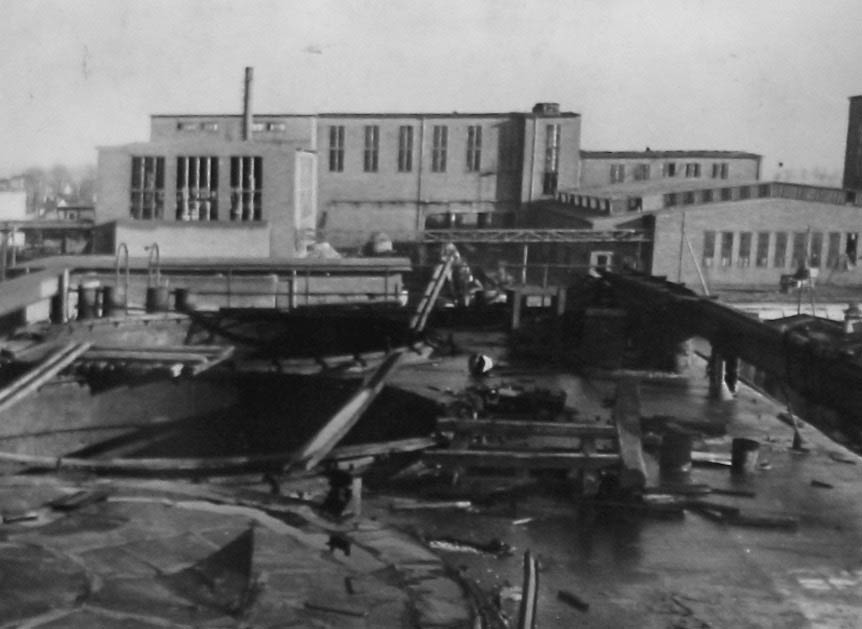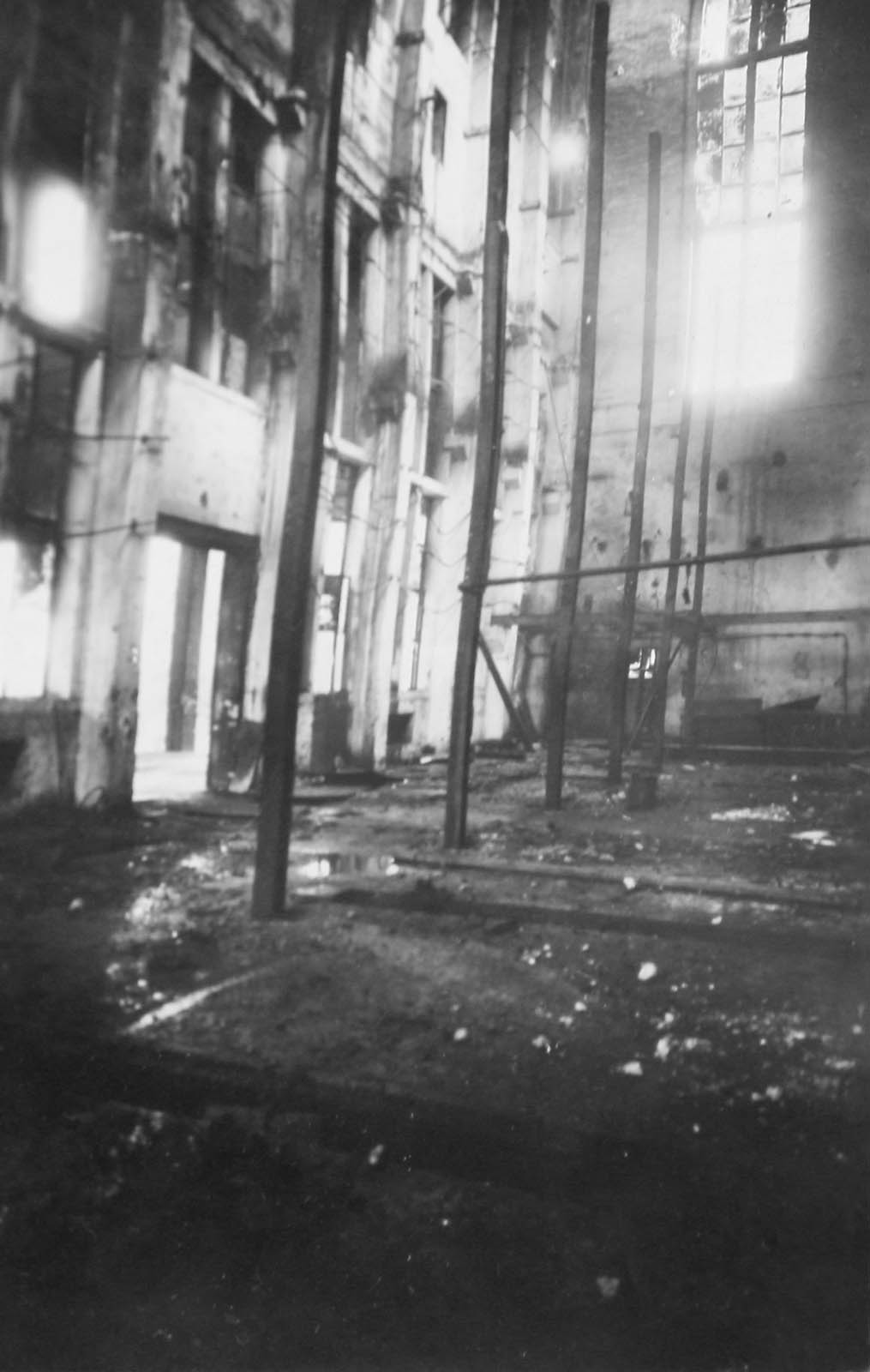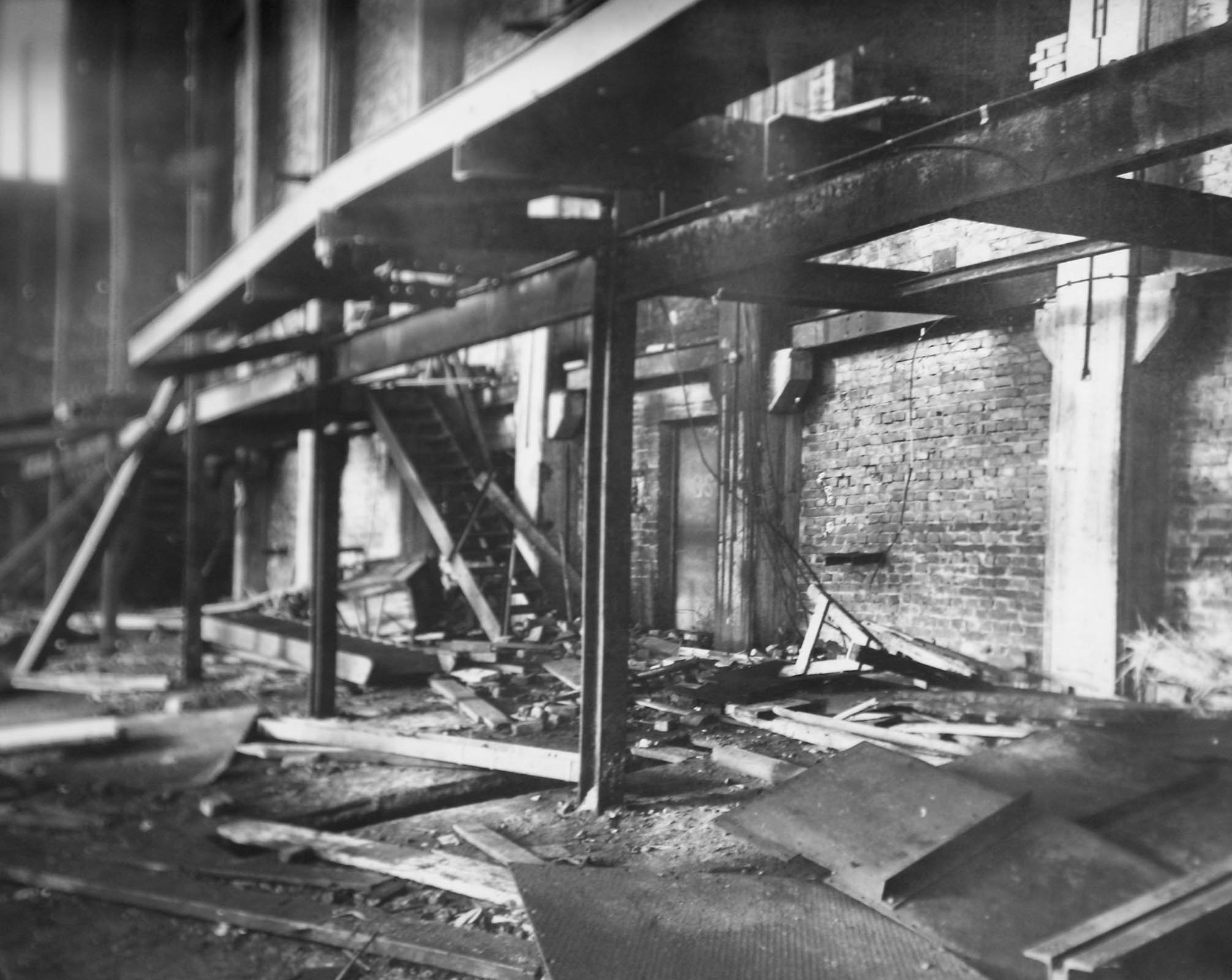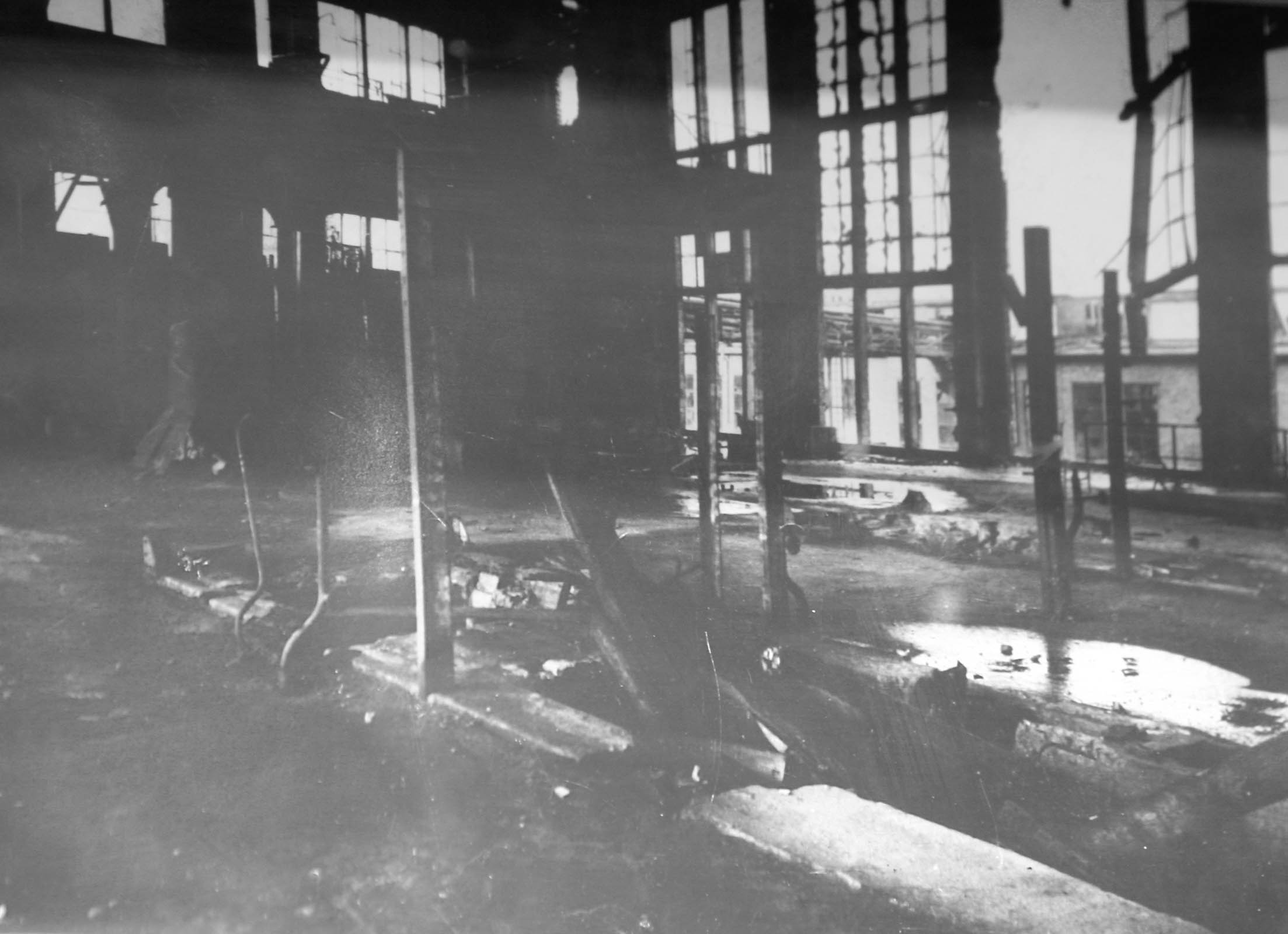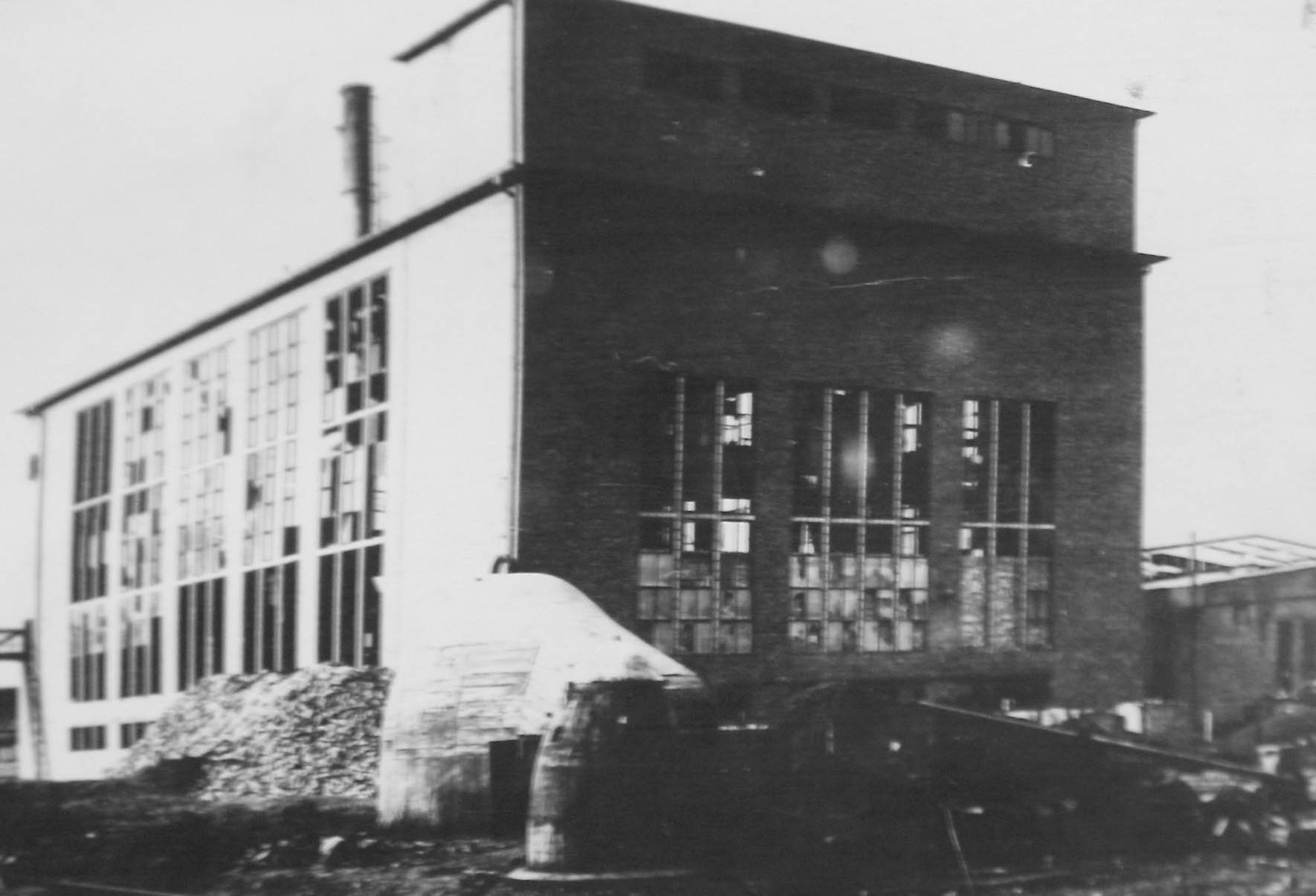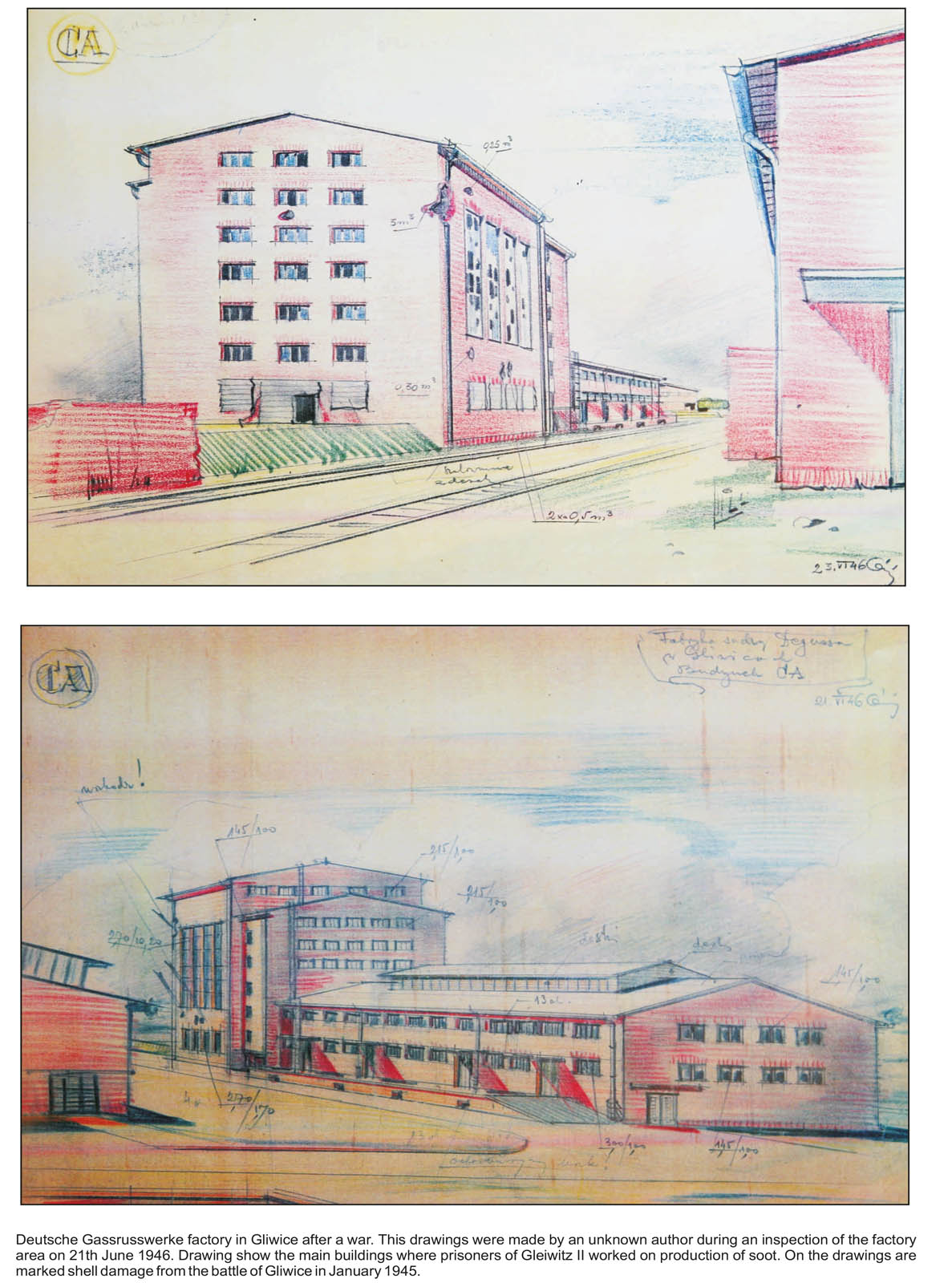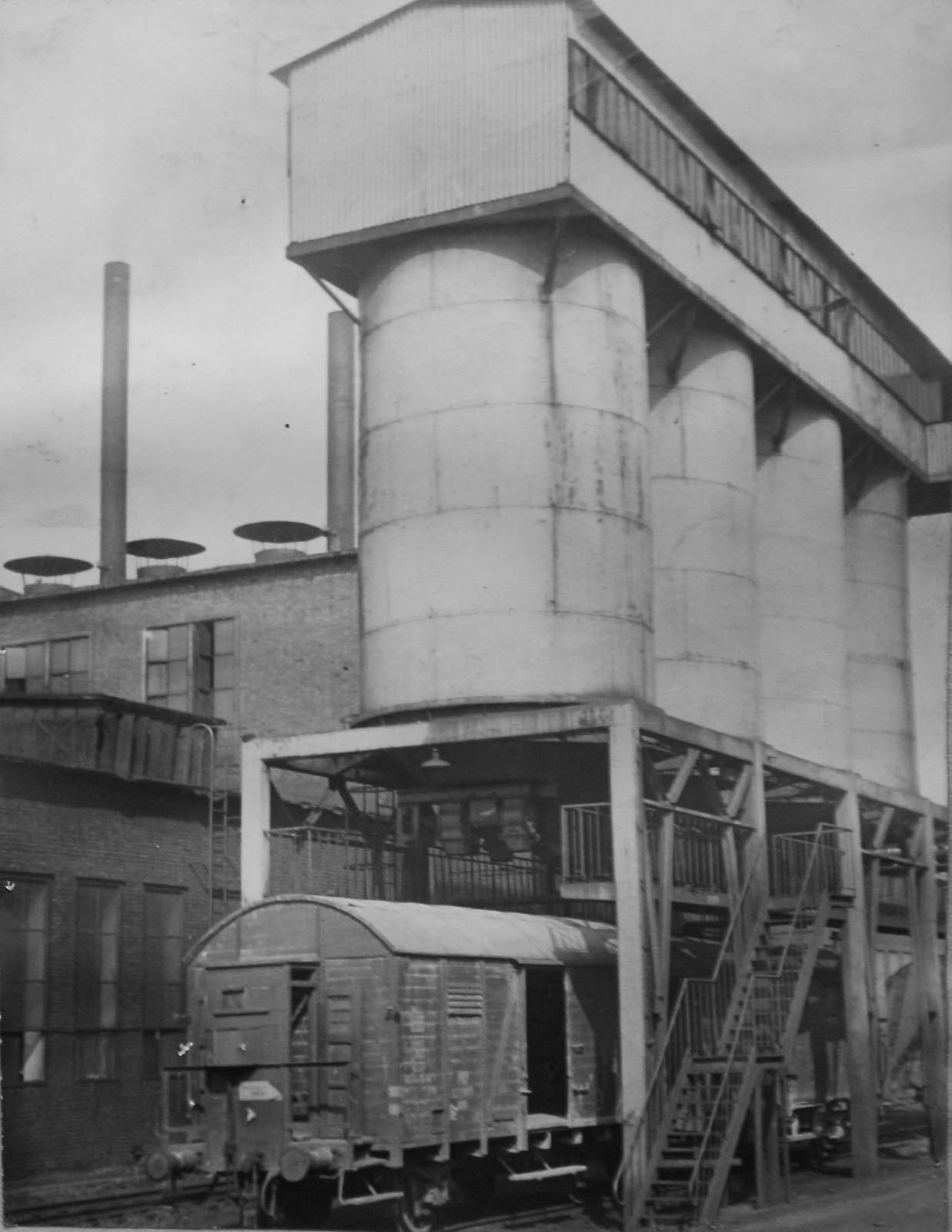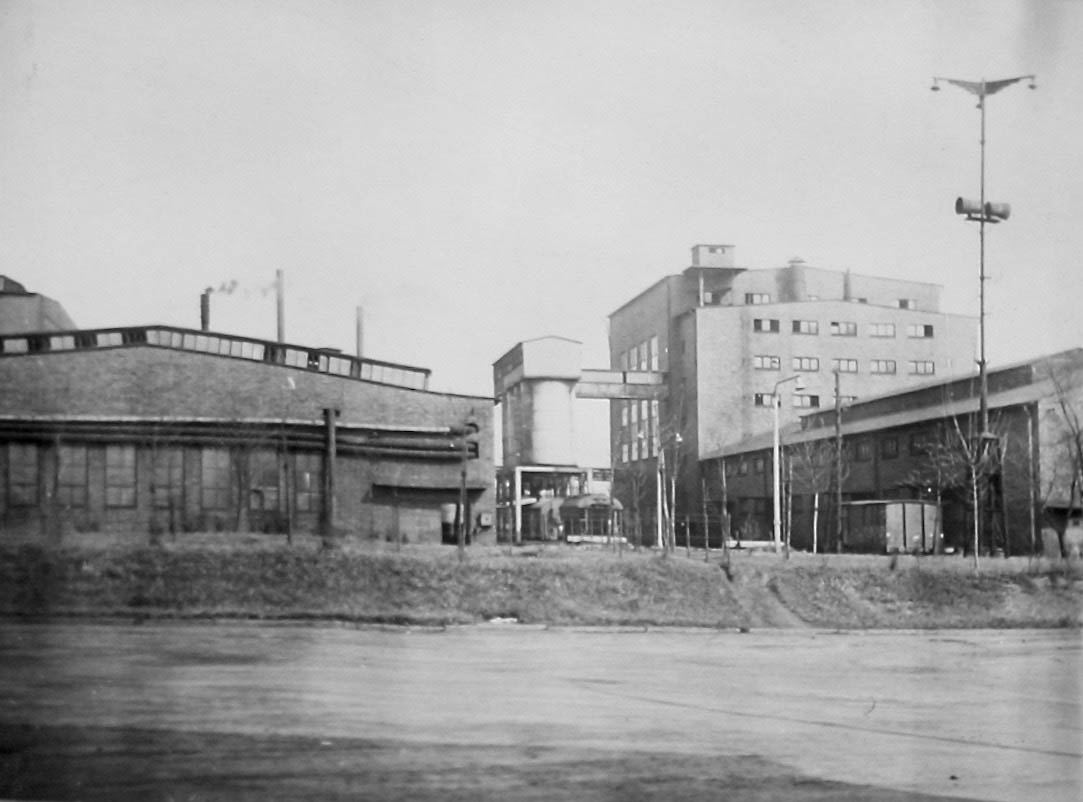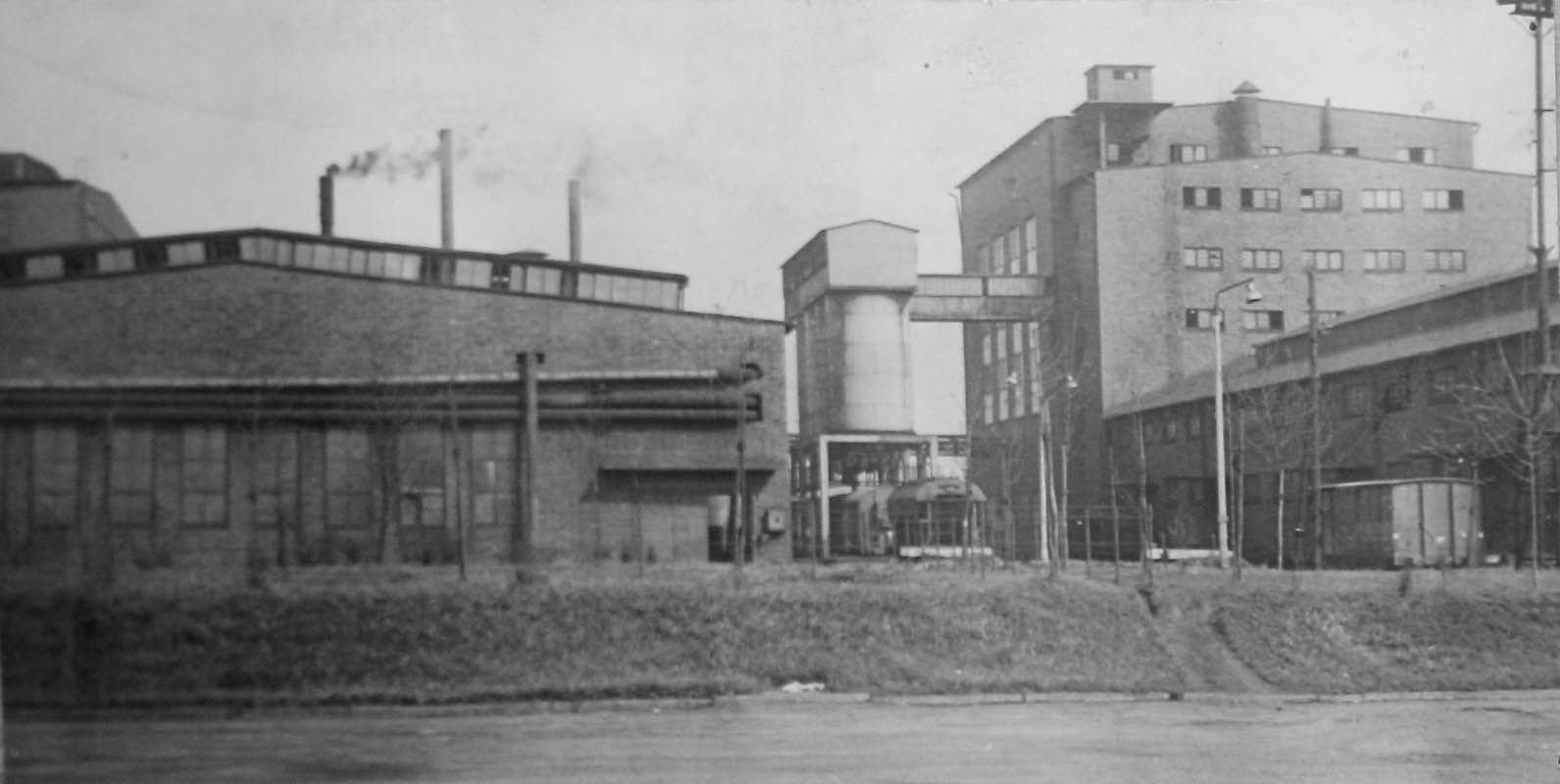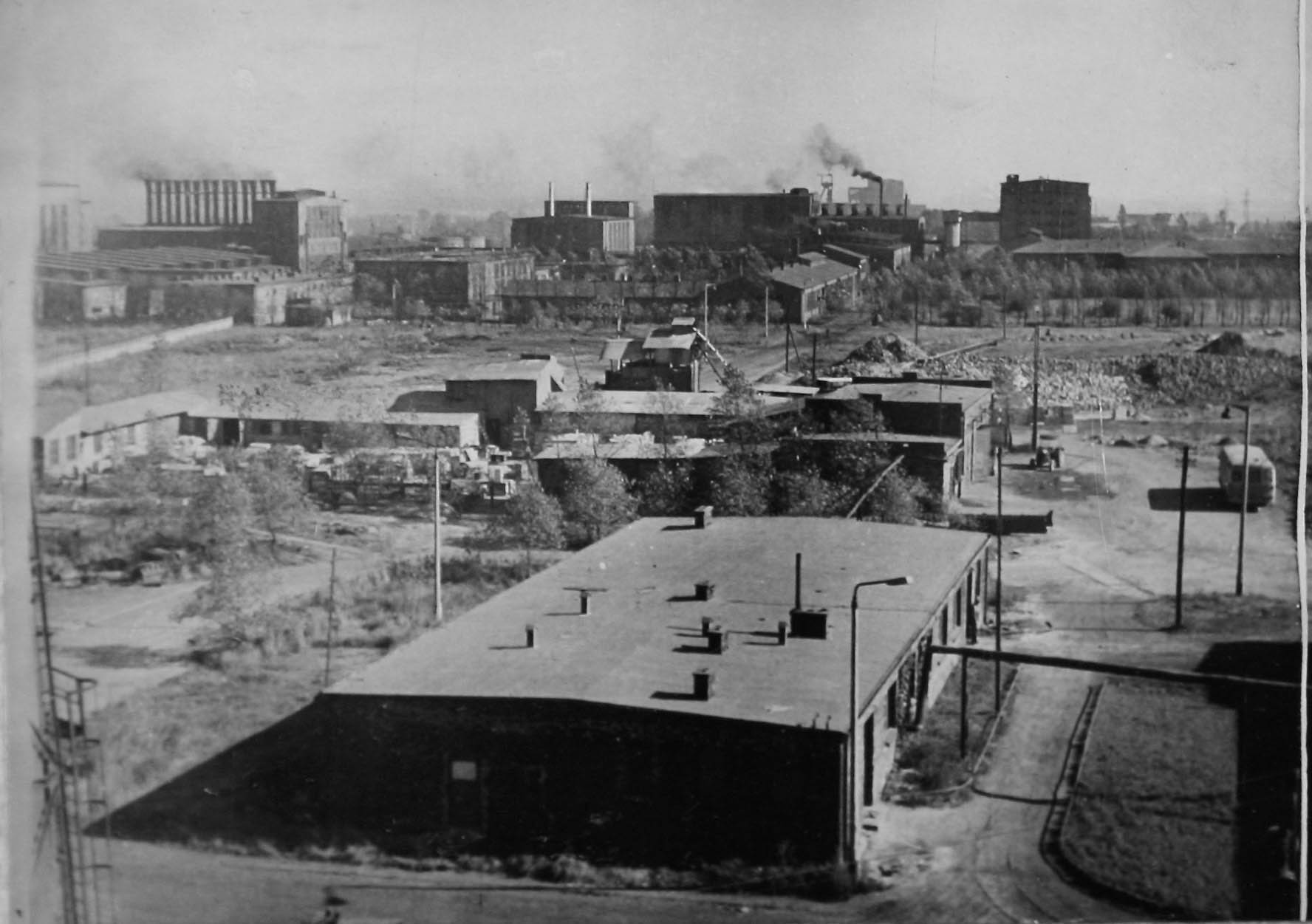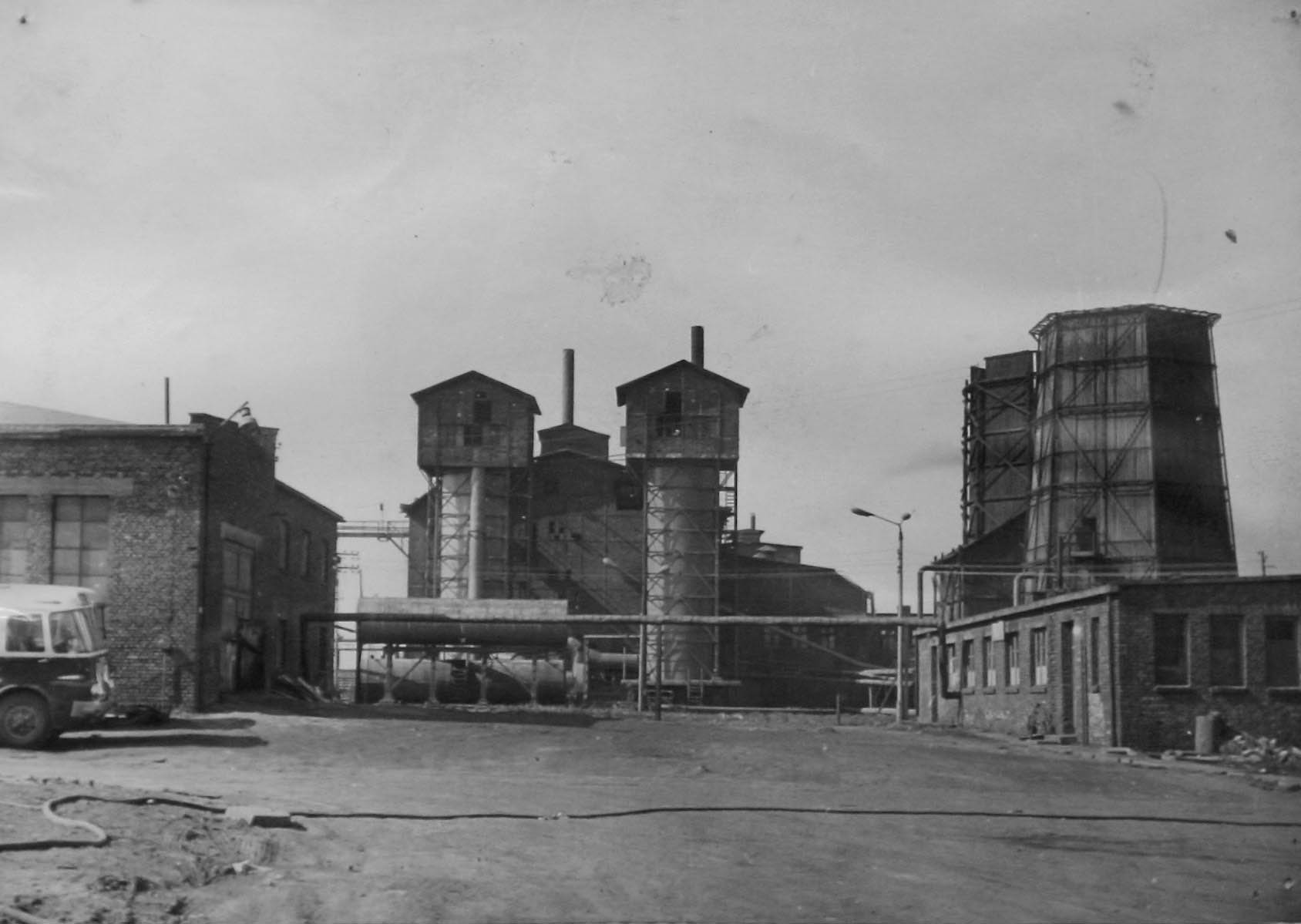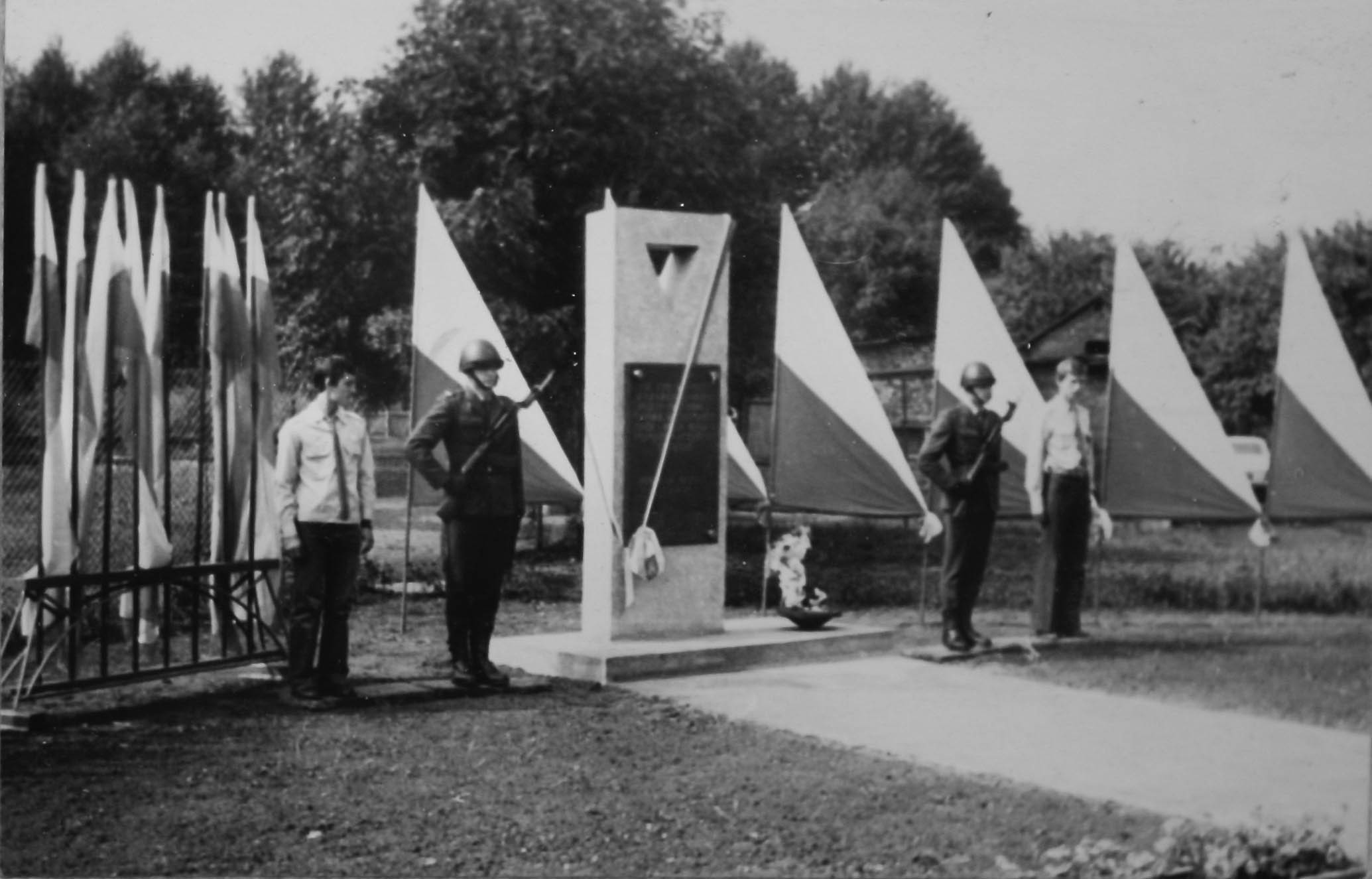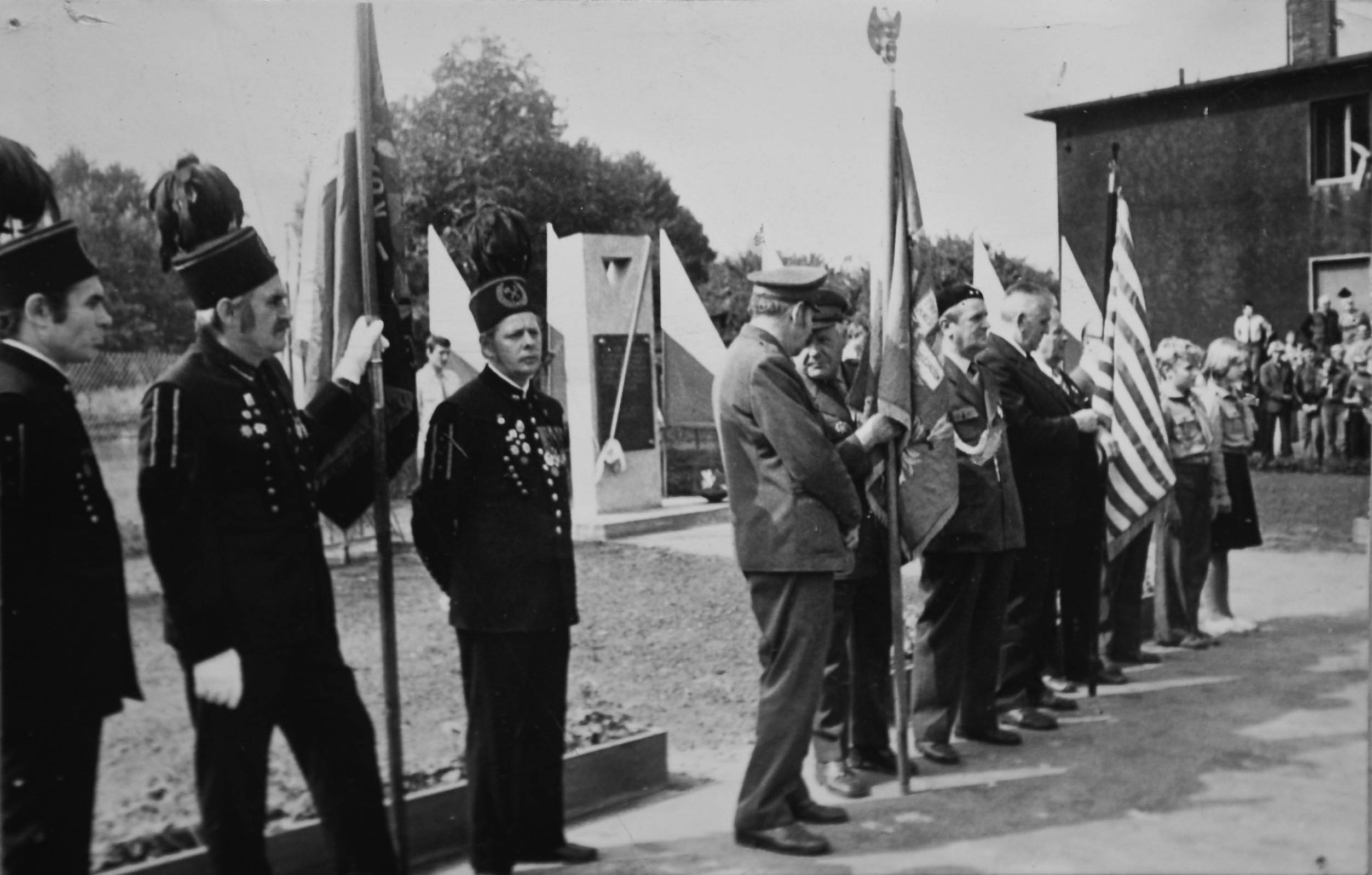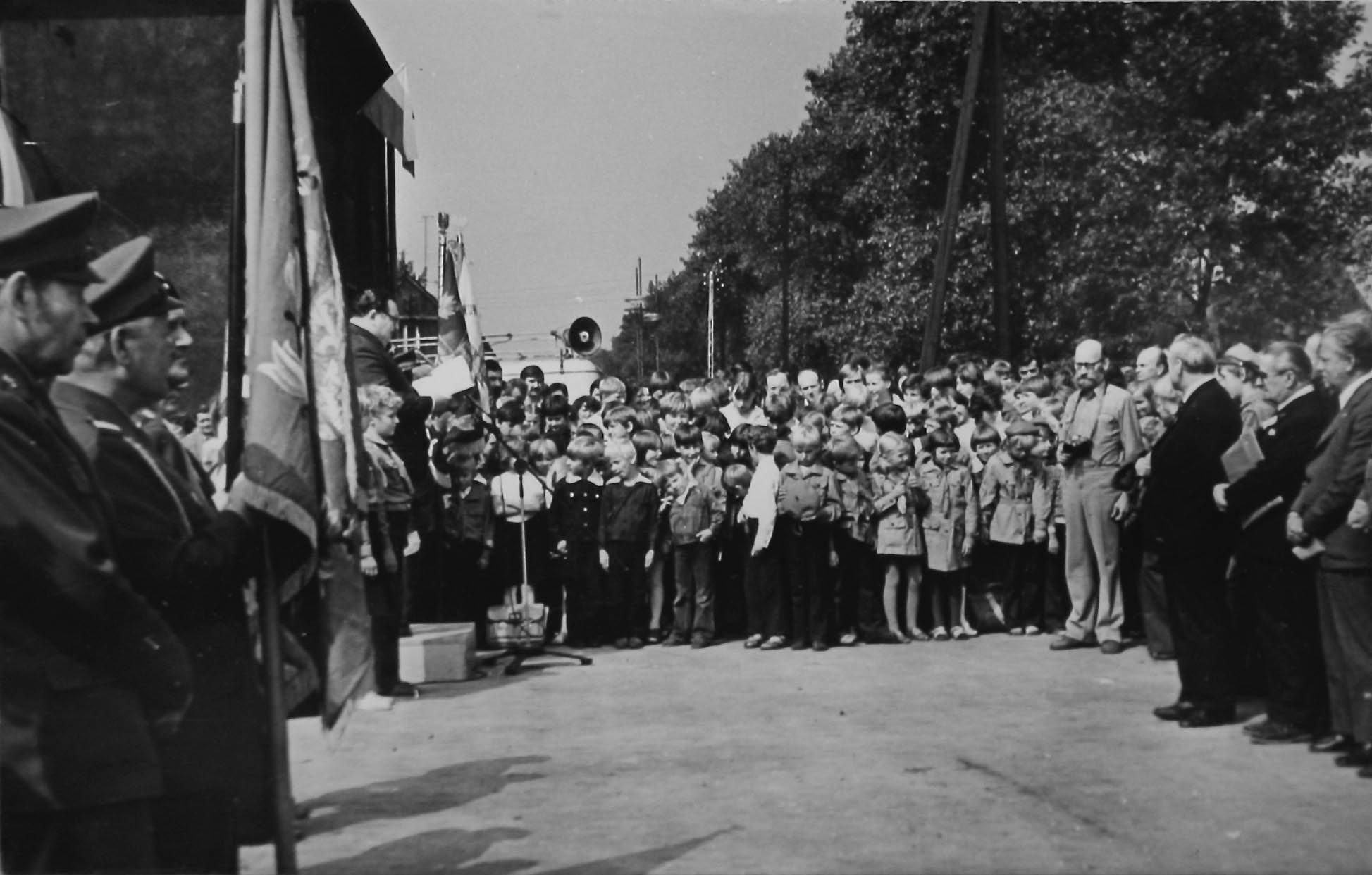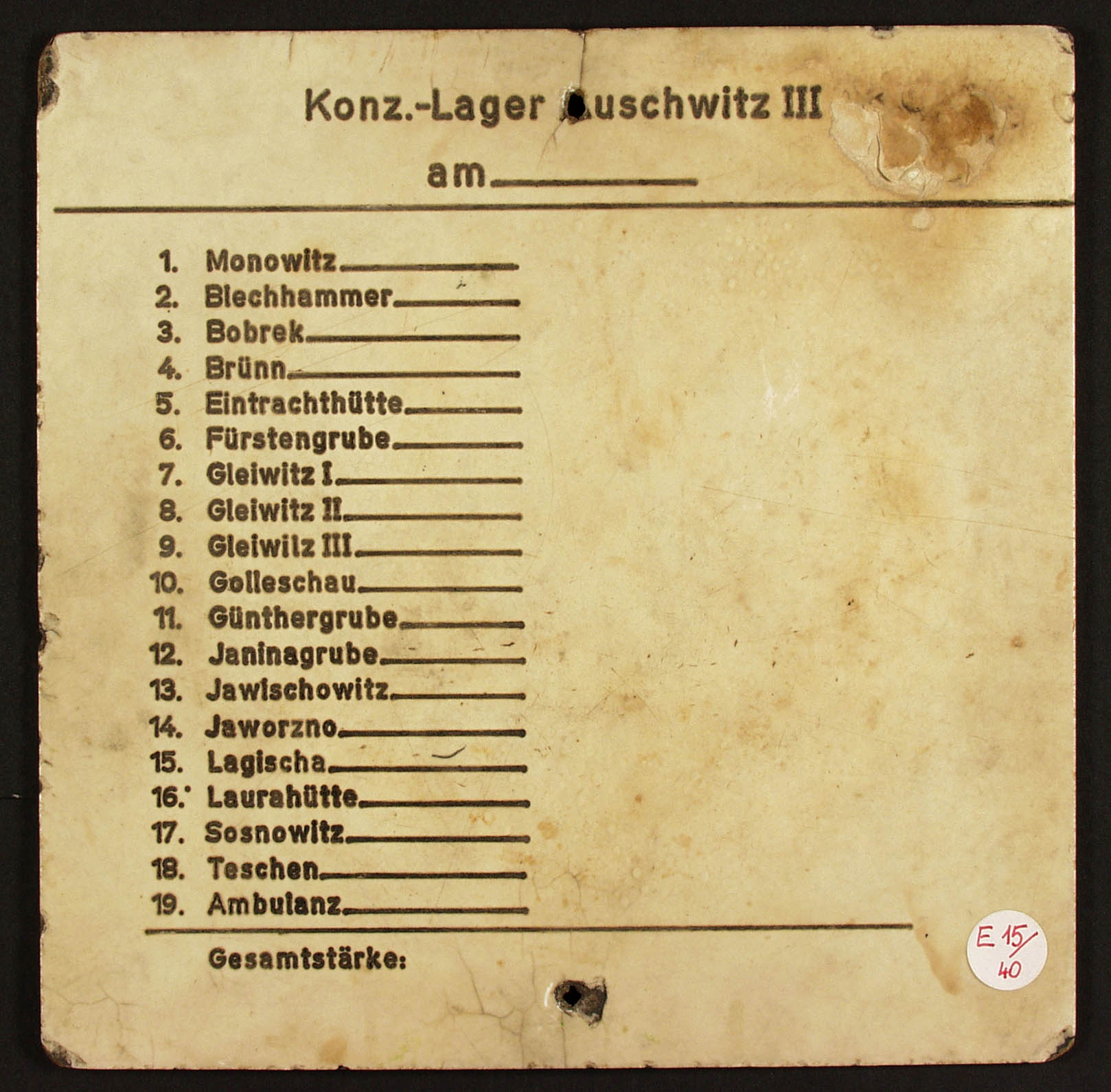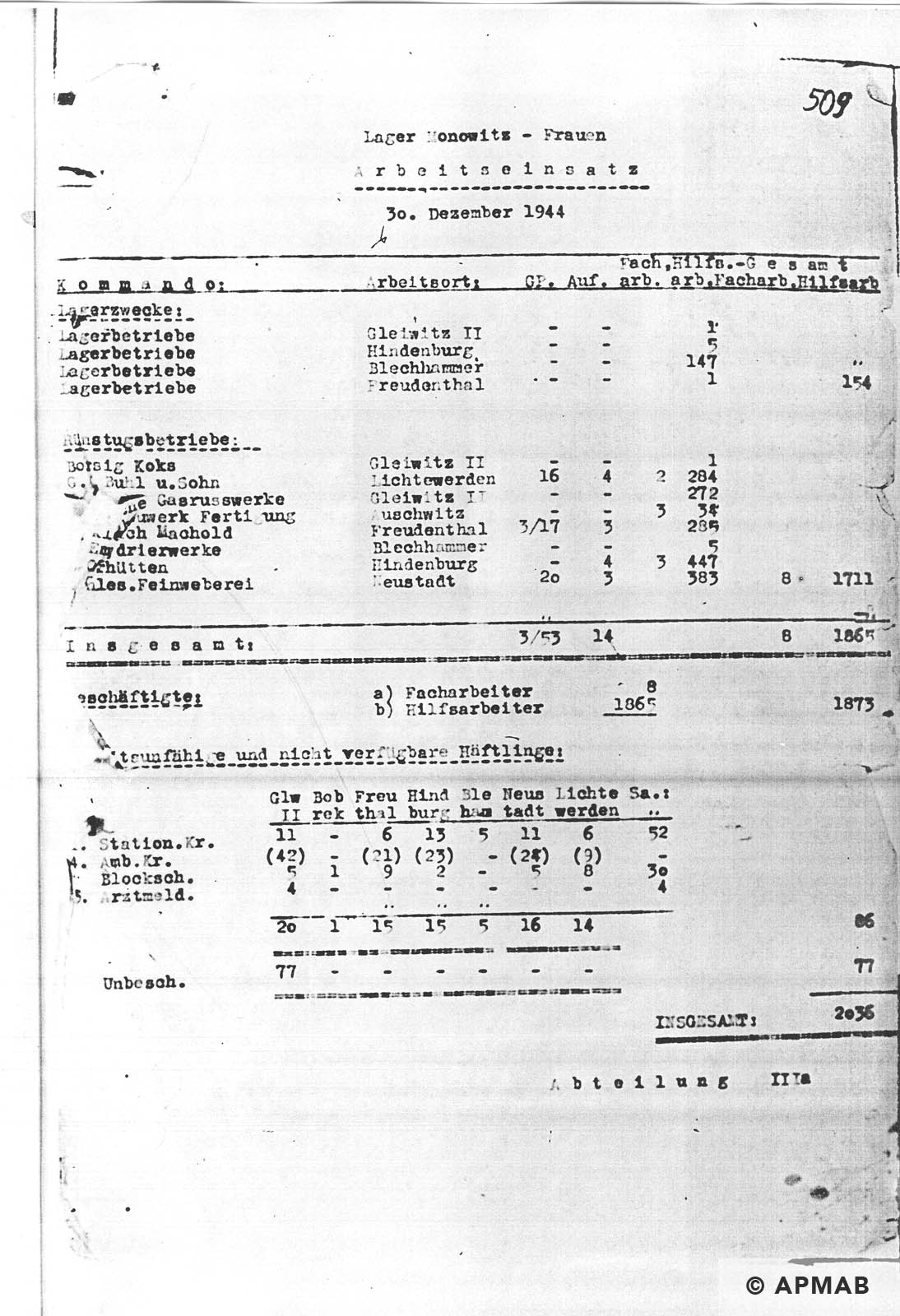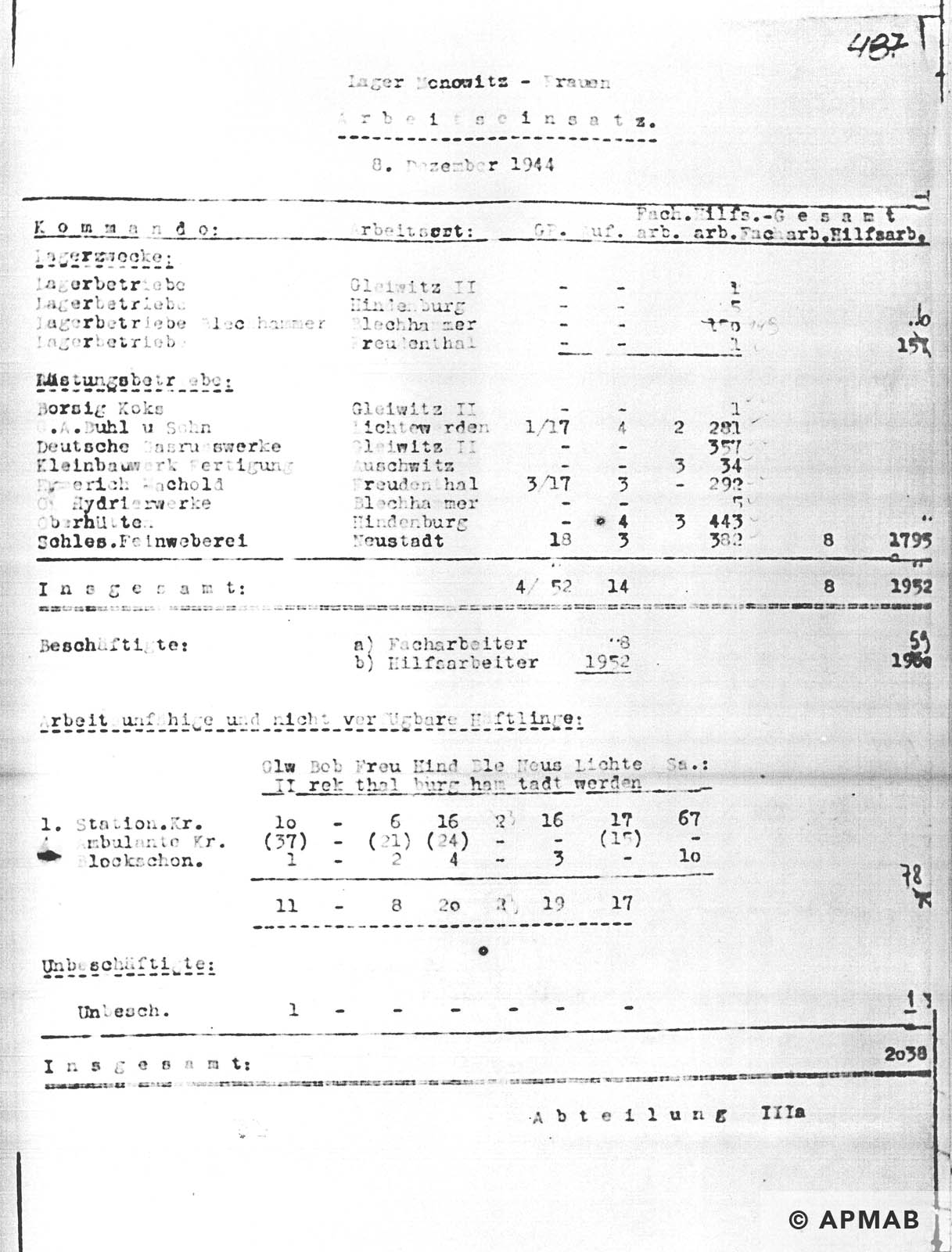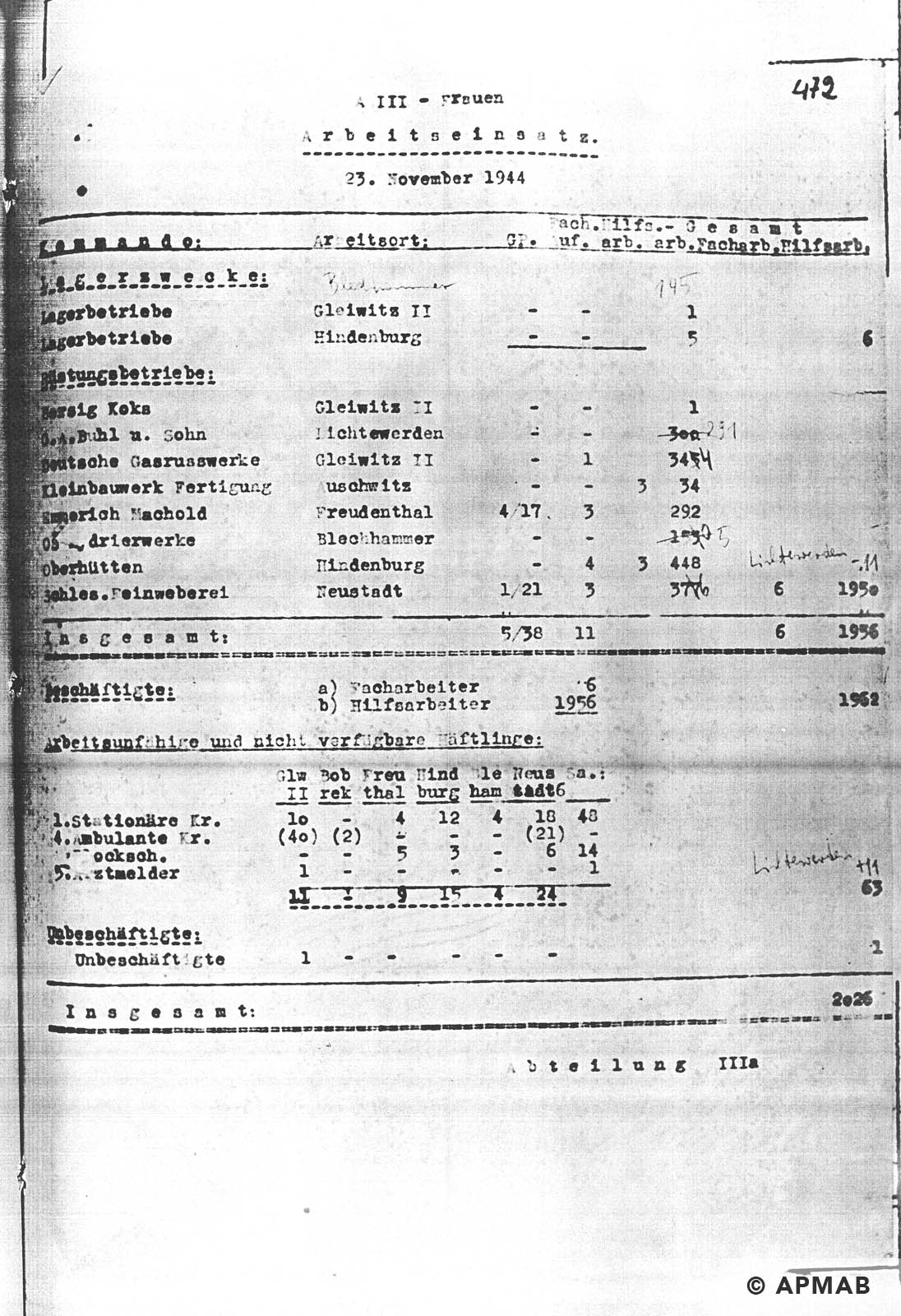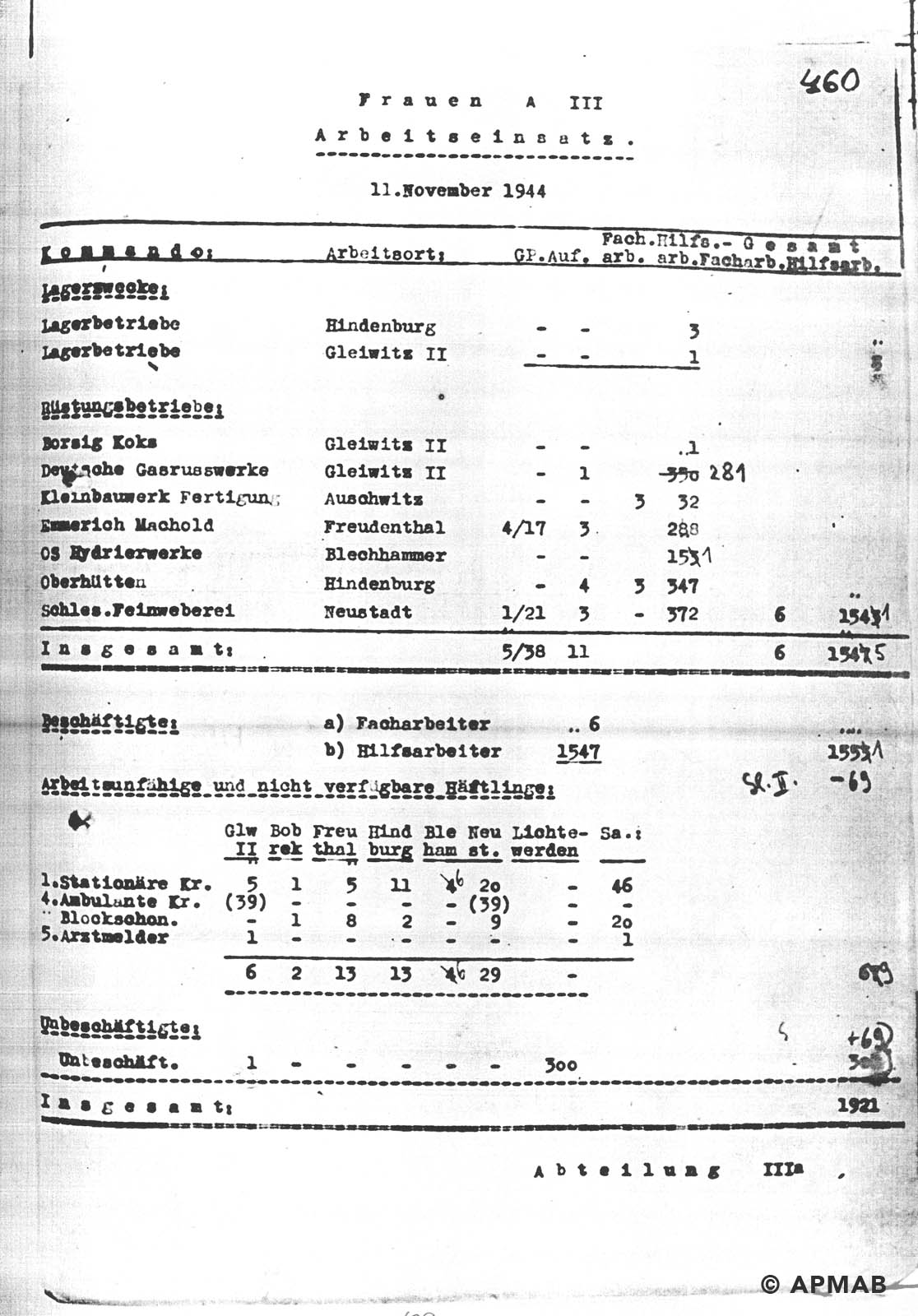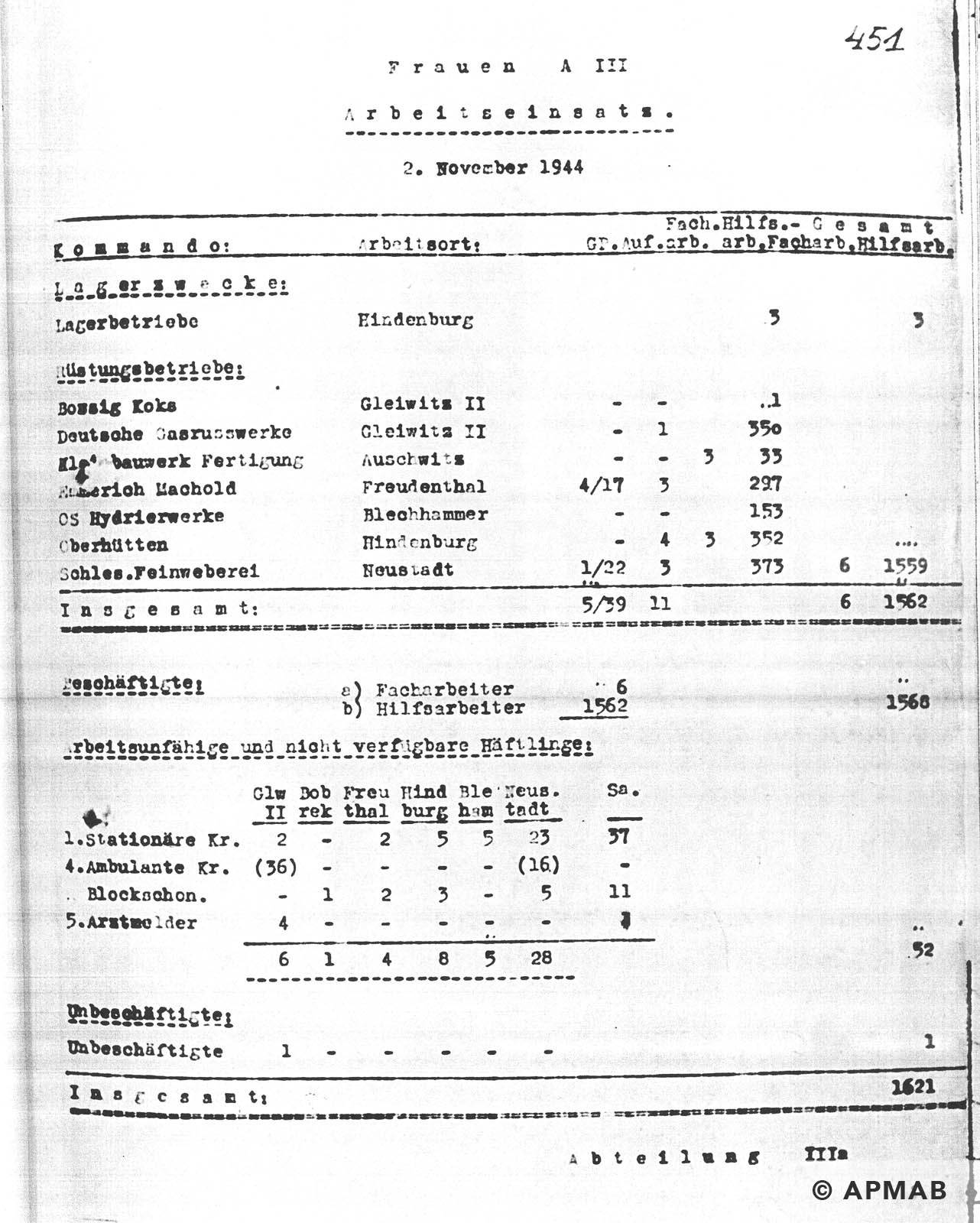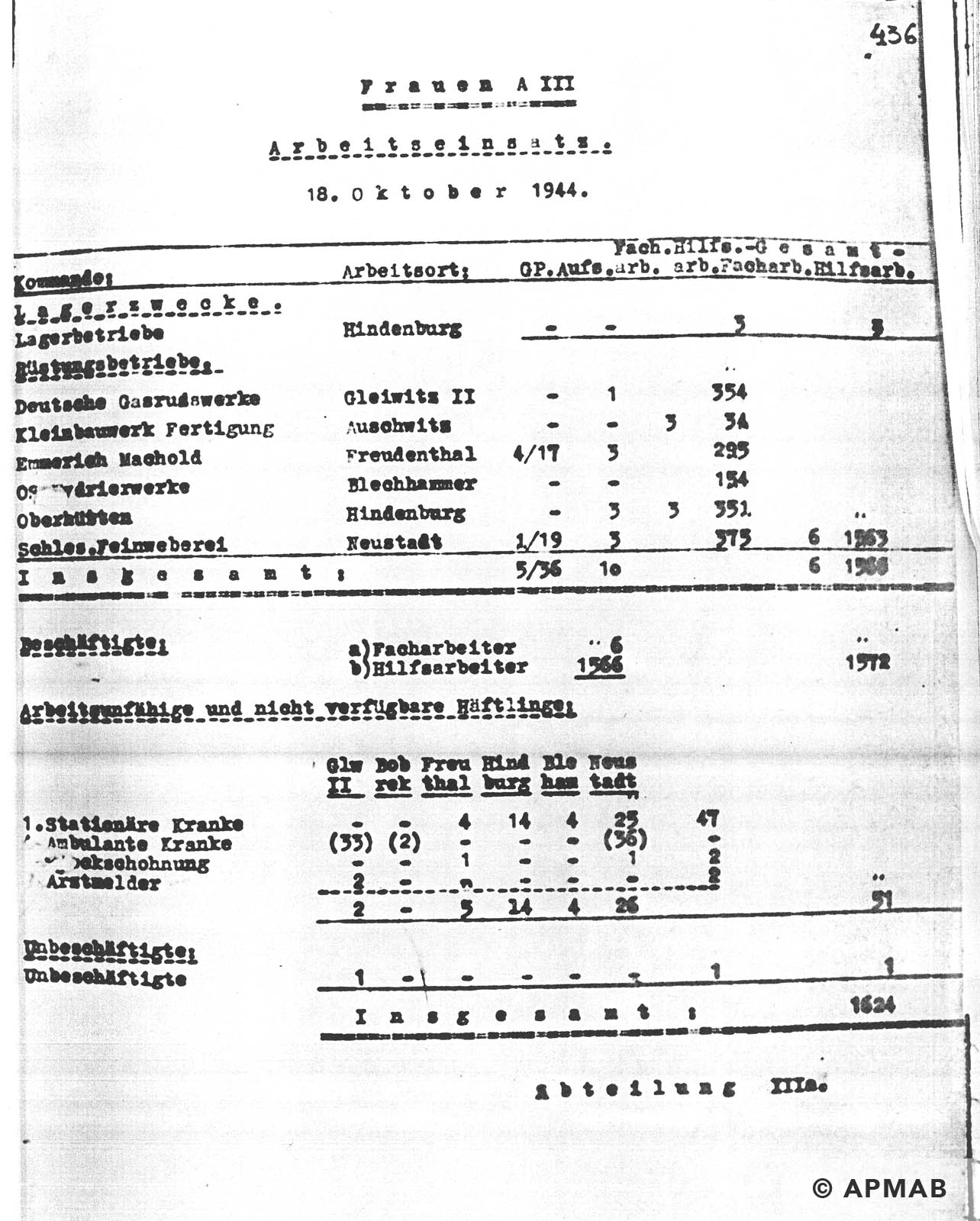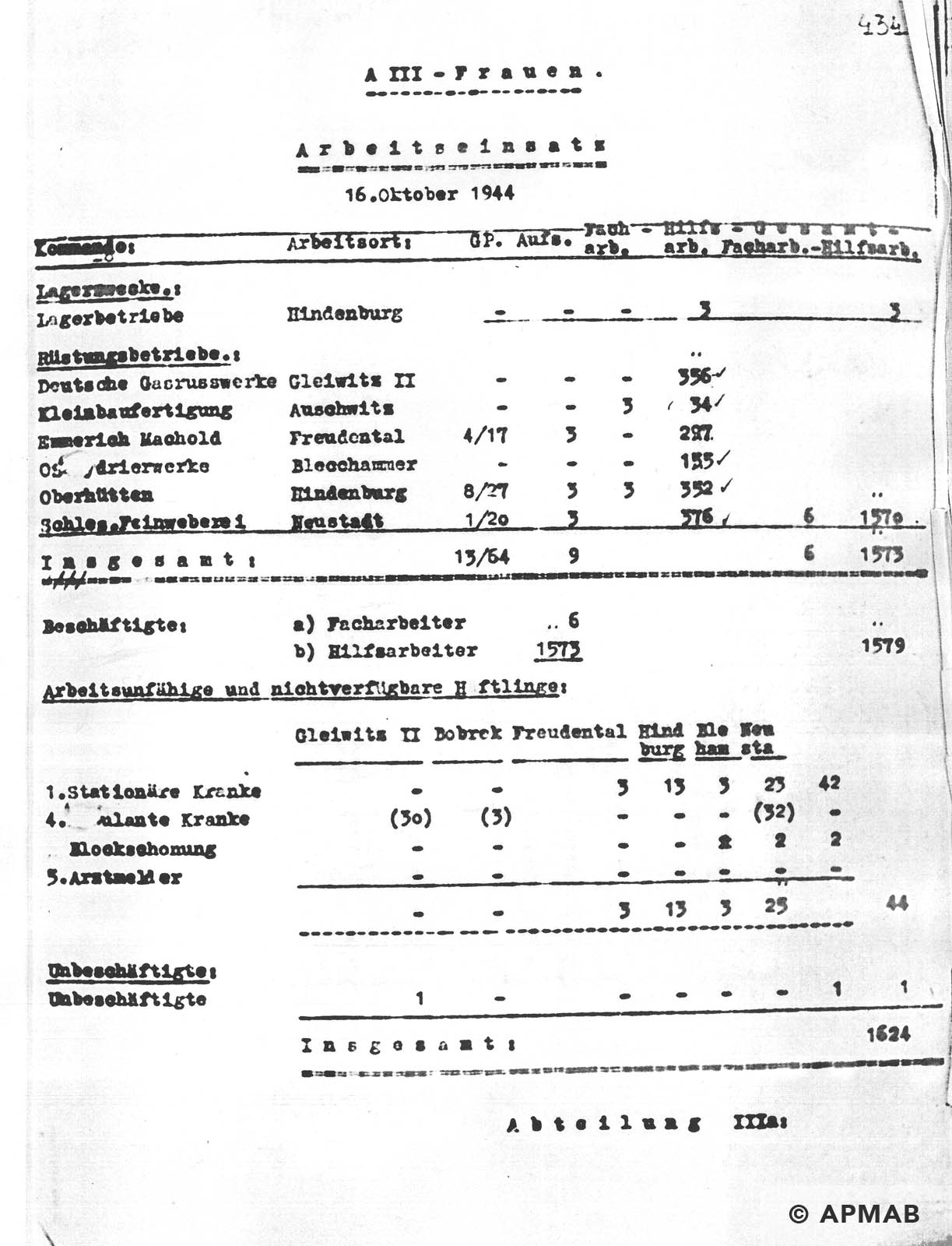Arbeitslager Gleiwitz II
Commandant of the camp
SS-Oberscharführer Bernhard Becker
SS-Oberscharführer Konrad Friedrichsen
SS-Hauptscharführer Bernard Rackers
Number of SS Guards
Approximately 70 SS men from the 6th Wachkompanie Monowitz. Predominantly Germans and Volksdeutsche from Poland, Romania, Croatia.
Work type
Oil and Chemicals: Production of lampblack (carbon black) (female prisoners), repair and maintenance of machinery, and factory expansion and coke plant (male prisoners).
Employer
Deutsche Gasrußwerke GmbH part of Degussa AG
Deutsche Ausrüstungswerke (DAW)
Borsig-Koks-Werke
Sub camp buildings
The buildings of the sub camp were taken over from the Schmelt forced labour camp for Jews.
Number of prisoners
740 male prisoners (on 17 January 1945) and 371 female prisoners (on 30 December 1944)
Nationality of prisoners
Mainly Polish Jews but also Jews from other countries including The Netherlands.
Period of camp existence
3rd May 1944 – 18 January 1945
Dissolution / Evacuation of the sub camp
On 18 January 1945 male prisoners were evacuated to the Sachsenhausen concentration camp, female prisoners were transported to Ravensbrück concentration camp.
Dates of site visits by Tiergartenstrasse4 Association
September 2005 and March 2007
Memorialisation
The memorial to the subcamp Gleiwitz II is about 200 meters from the site of the actual sub camp. In 1979, a small monument was erected there with an inscription in Polish.
Explore more
The History
The history of the companies and the places prisoners worked, the sub camps, the SS guards and memorialisation of the sites.
The History of the Deutsche Gasrußwerke GMBH
Soon after the beginning of the Second World War, the German company Deutsche Gasrußwerke GmbH from Dortmund built a factory for the production of lampblack (carbon black) on ul Pszczyńska in Gleiwitz (Polish Gliwice). Carbon black or lampblack is a material produced by the incomplete combustion of heavy petroleum products such as coal tar. Carbon black is a natural pigment and is also used as a reinforcing filler in tyres and other rubber products. The plant was built in Gliwice on the initiative of Deutsche Gasrußwerke GmbH near a Zwangsarbeitslager (forced labour camp) for foreign workers and a slave labour camp for Jews which was then under the control of Organization Schmelt. [1]
The Deutsche Gasrußwerke GMBH had been founded in 1936 as Russwerke Dortmund and began operations in 1938 in Dortmund with the industrial production of carbon black using the so-called “Gasrußverfahren” [2]
An extensive account of the operation of the Jewish forced labour camp and subsequent Auschwitz sub camp of Gleiwitz II was given after the war by former prisoner Franciszka Zajdman, “In 1943 I worked in Sosnowiec in the tailoring workshop of the Held Company. The Company of Held and Brothers was based in Berlin. There was a branch in Sosnowiec. The Company Held had in Sosnowiec tailoring workshops, where uniforms were made for the Wehrmacht (…). It was a job for which you got an Ausweis, which protected against deportation for forced labour (…).with my whole family I lived in the ghetto of Sosnowiec. We were led from the ghetto to work in a single group and brought back in the evening in the same way. One day in March 1943, the workshop in which I worked was surrounded by Jewish militia and all persons working there on that day were arrested. They brought us to a transit camp in Sosnowiec where we were detained for two days (…). After 2 days we were transported to another transit camp, this time in Gogolin.[3] It was a makeshift camp, where you waited to be assigned to work. Then came, the directors of various companies, to select their required workforce. The SS man named Ludwig seconded for this purpose from the Arbeitsamt selected the women for each job.[4] After several weeks the technical director of the lampblack factory in Gliwice, SS Dr. Schenk Ludwig chose the woman for his factory while the rest of our group were to be sent to Bergen-Belsen (probably for weaving) – we asked Ludwig, whether those of us brought from Sosnowiec could be sent to work together and not separated. With the exception of one person we were all assigned to Gliwice. About 200 women were brought to the camp in Gliwice. Prior to our departure a Kapo (selected from amongst the Jewish women in Gogolin) was sent to the camp to prepare for our arrival. We were transported by rail. We came to Gliwice in the morning. From the railway cars we were transported on trucks into a labour camp that was located near the lampblack factory on ul Pszczyńska and named Gleiwitz-Steiger [5] The camp was fenced off with barbed wire and was divided into two parts: male and female. On our arrival – in the men’s camp there were already prisoners – Jews. This camp was predominantly Jewish – all of us who arrived were Jewish. Among the prisoners were Jews of various nationalities. I heard that when constructing the first factory building (when we arrived this was the only hall, and when we were evacuated there were three halls) a lot of Dutch Jews were killed…. in addition forced labourers worked there, Poles (who were our only contact with the outside world) and the French, who were billeted in the barracks next to our camp but remained on a free footing, (…). on arrival we were placed in a number of wooden huts……At the same time the foremen trained us on the work in the factory. Most of us were assigned to work on the production and packaging of lampblack. In general, the entire production cycle was staffed by women. The men only carried out the maintenance of machinery and built a further two halls. The foreman of the men – who carried out the maintenance of the machinery – was a man named Ludwig, who reportedly gave help to the prisoners, but he did not allow anybody to talk about it. The more intelligent and faster women were assigned to handle the production apparatus. I found myself in this group. The foreman a German man named Saks taught us how to use the machinery. He had anti Hitler views. He stayed briefly at the factory. After training us, he left immediately. I worked at an evaporator machine.. it processed oil into lampblack…there were 12 evaporator machines in the room. It was less clean and colder work. On the production floor during the summer it was about 60 degrees. The whole time I was in Gliwice I worked on the above mentioned apparatus. The whole time I ran the machine I sabotaged the process. Every hour I had to record the amount of carbon black produced. A higher temperature was needed for more production. I lowered the temperature especially at night so that the carbon black vapour from the evaporator floated away from the unprocessed oil and not into the buckets. (during the day there were limited possibilities). At the moment when he was approaching my condenser, the foreman quickly raised the handles of the device raising the temperature so that the flames were high but the thermometer showed low heat. I reported then that the condenser had failed and there were cases when the condensers were withdrawn.
In this way, every hour the production of carbon black instead of being 5 kg was 1.3 or 1.5 kg. I falsified the reports. Every morning a Kapo supervising work on the day and night shifts (we worked in three shifts) literally fought to get the amount of production up. One day one of the SS men – Unterscharführer (I do not remember the name) beat two kapos – Balbina Grylach and Maria Kilberg and took them to the guardhouse…..Over time, I induced the prisoner Tula Bekier to sabotage. Since then, we stood together during the night shift with buckets of unprocessed oils. Once hot oil spilled out and I burned my hand badly. I note that it was possible to conduct sabotage in this way because there was always some oily waste during production which poured into the finished tank. The Technical Director of the factory – Schenk – when he came to review the production, and reviewed the results often looked at me and smiled slightly. Schenk was a man who for us inmates was a big support. He addressed us in a very friendly way. He always tried to defend us, especially the older women. We were never denounced by the foremen. To give older women lighter work he organized small garden plots… At first he spoke directly to us. Later, when our labour camp was transformed into a branch of the Auschwitz concentration camp, the SS told him only to speak to us through them .” [6]
[1] Forced labour camp for Jews – Judenlager also known under the names Rü Lager (Rüstungslager) Degussa, Gleiwitz-Steigern or Zwangsarbeiterlager Degussa operated from February 1941, At that time it was for women prisoners, but in August of the same year barracks were also built for men. See Vorläufiges Verzeichnis der Konzentrationslager und deren Außenkommmandos sowie anderer Haftstätten unter dem Reichsführer-SS in Deutschland und deutsch besetzten Gebieten (1933-1945), Comité International de la Croix-Rouge, International Tracing Service, Arolsen 1969 as well as Verzeichnis der Haftstätten unter dem Reichsführer-SS. Konzentrationslager und deren Außenkommmandos sowie anderer Haftstätten unter dem Reichsführer-SS in Deutschland und deutsch besetzten Gebieten (1933-1945), Comité International de la Croix-Rouge, International Tracing Service, Arolsen 1979.
[2] The brief history of the company is from the website of the Deutsche Gasrußwerke Gmbh & Co: https://www.gasruss.de/. The information was taken from the website on 28th July 2019.
[3] It was not a transit camp, but one of the Zwangsarbeitslager – forced labour camps for Jews controlled by Organization Schmelt. Gogolin forced labour camp was founded in March 1940 and was liquidated in January 1945. It was divided into male and female sections. The camp was located at the end of the current ul Szkolna. In the camp in Gogolin were Jews from Czechoslovakia, Belgium, The Netherlands and Poland. The average number of prisoners in the camp was about 600. The inmates worked on the construction of the highway, and in farming. From time to time selections in the camp were carried out, and the sick and prisoners unable to work were taken to Auschwitz-Birkenau. See: Obozy hitlerowskie na ziemiach polskich 1939-1945. Informator encyklopedyczny, Warszawa 1979, Vorläufiges Verzeichnis der Konzentrationslager und deren Außenkommmandos sowie anderer Haftstätten unter dem Reichsführer-SS in Deutschland und deutsch besetzten Gebieten (1933-1945), Comité International de la Croix-Rouge, International Tracing Service, Arolsen 1969 oraz Verzeichnis der haftstätten unter dem Reichsführer-SS. Konzentrationslager und deren Außenkommmandos sowie anderer Haftstätten unter dem Reichsführer-SS in Deutschland und deutsch besetzten Gebieten (1933-1945), Comité International de la Croix-Rouge, International Tracing Service, Arolsen 1979.
[4] It was Bruno Ludwig, representative of Organization Schmelt.
[5] Gleiwitz-Steigern (Gliwice-Sztygarów) is the German name for Ligota Zabrskiej. The settlement took its present name probably from the term Ligota near Zabrze. In the years 1935-1945 it was named Gleiwitz-Steigern (Gliwice-Sztygarów), while after 1945 it took the name Ligota Zabrska (see the territorial regeneration scheme – Ligota Zabrska, City of Gliwice, 2007, p. 13). Irena Strzelecka in her paper on Arbeitslager Gleiwitz II, [in:] Zeszyty Auschwitz [1972] Nr. 14, p. 95-114) reports that the Judenlager also had other names: RU Lager (Rüstungslager) Degussa, Zwangsarbeiterlager Degussa, Deutsche Gleiwitz-Steigern Gasrusswerke GmbH. The Degussa name implies, of course, the corporation Degussa AG Frankfurt, which was (and still is) one of the main shareholders of Deutsche Gasrusswerke in Dortmund. Degussa AG during the Second World War was not only interested in building a new plant in Gliwice producing carbon black but took over in 1939 the refinery in Jaslo, in which there was a plant producing carbon black. Degussa-Huls A.G. bought the plant and refinery and attached power station in Jaslo, in 2000.
[6] APMAB. Zespół Oświadczenia, testimony of Franciszka Zajdman, Vol. 39, p. 42-45.
The Post War History of CARBOCHEM and Deutsche Gasrußwerke GMBH
After the war the Deutsche Gasrußwerke GMBH continued operations in Dortmund. 1954 saw an expansion of the production facilities and the introduction of the technology for the Furnace Black process; production started in 1956. In 1983, the company started producing electricity from the post-combustion of the residual gas, produced as a bi-product of carbon black. Since 1994, Deutsche Gasrußwerke GMBH has provided district heating delivery to the city of Dortmund. [1] District heating is a system for distributing heat generated in a centralized location through a system of insulated pipes for residential and commercial heating requirements. In 2006, the company produced its 4 millionth ton of carbon black since the company was founded and in 2016, celebrated its 80th anniversary. Today it is a medium sized company in Dortmund and a major producer of carbon black. [2]
The Gasrußwerke plant was partly destroyed at the end of the war. It was taken over in May 1945 by the company Gliwicki Zakłady Chemiczne “CARBOCHEM” and rebuilt. The company continued operations until 2002 when it went into bankruptcy.
[1] The brief history of the company is from the website of the Deutsche Gasrußwerke Gmbh & Co: https://www.gasruss.de/. The information was taken from the website on 28th July 2019.
[2] The brief history of the company is from the website of the Deutsche Gasrußwerke Gmbh & Co: https://www.gasruss.de/. The information was taken from the website on 28th July 2019.
The History of the Sub Camp Arbeitslager Gleiwitz II
On 3 May 1944 Zwangsarbeitslager Degussa (also known as Gleiwitz Steigern; Rü. Lager Degussa, Gleiwitz – Steigern), in which there were 245 female and 261 male prisoners all Jews, was taken over by Auschwitz III-Monowitz.[1] The former head of the Jewish Zwangsarbeitslager, a man named Jungnickel was removed and replaced by SS-Oberscharführer Becker, and his deputy SS-Unterscharführer Lukaszek.
The Deutsche Gasrußwerke in Gliwice occupied the area between the streets: ul Dojazdowa from the north, ul Pszczyńska (then Plesser Strasse) from the east and ul Pocztowa (then Zufahrtstrasse) from the south. The western part of the factory was adjacent to wasteland and fields. The Gleiwitz II sub camp was located in the northern part of the plant. After the takeover of the Zwangsarbeitslager by Auschwitz III-Monowitz modification works began on the camp. First the wire fencing of the camp was connected to the mains electricity. New barracks were built and the old ones were whitewashed and expanded so that every shift change had its own barrack. The new barracks each housed about 120 people.
On the ul Pszczyńska side, barracks were built for the SS guards of the sub camp and also storage barracks (e.g. for potatoes). The main gate of the sub camp Gleiwitz II led to the SS area. The entire camp was an irregular rectangle with a length of approximately 200 meters and width of a few dozen metres to up to 100 m width. The entire area was surrounded by a single row of electrified barbed wire, stretched on concrete posts at intervals of three meters. The camp was split into male (east) and female (west) sections. In the northern part, in order to fully isolate the prisoners from the outside world a wooden fence with a height of about 2 m was also built. At the fence there were a number of gates. One of them was an internal gate through which you could pass from the male to female sections of the camp, while another gate in the female section allowed direct access into the Gasrußwerke. Around six wooden guard towers were built, and also one-man concrete air raid bunkers. [2]
The transfer of the prisoners from the Zwangsarbeiterlager to the authority of Auschwitz III-Monowitz took place as follows: the SS gathered all the prisoners together and the prisoners were taken to the factory, where they were stripped naked and disinfected. All their clothes were taken, and they were issued with standard striped prisoner uniforms and thick underwear. The prisoners new clothing was supplied from the stores in the main Auschwitz camp. [3] The men’s hair was cut, but not the women´s. [4]
On 24 May 1944 five Polish prisoners working in the Auschwitz Political Department were brought to Gleiwitz II, and tattooed the prisoners with numbers from the general series. [5] Former prisoner Franciszka Zajdman remembered: I received the number 79207. The women’s tattoos were small, not conspicuous. Although we were Jewish women – the numbers we received were not from series A.” [6]
On 27 November 1944, from the women’s camp of Auschwitz-Birkenau 12 female prisoners were sent to the subcamp Gleiwitz II. On November 29 they began working at the Deutsche Gasrußwerke. In this way, the number of prisoners of the sub camp Gleiwitz II increased from 359 to 371. On the basis of surviving work lists it is known that at that time 356 prisoners worked in the Deutsche Gasrußwerke, one at the coke plant Borsig-Werke, one was employed in the sub camp, 12 were in the infirmary and one did not work at all. [7]
The work in the Deutsche Gasrußwerke was extremely strenuous. After the takeover of the Zwangsarbeitslager by Auschwitz III-Monowitz contacts between the men and women prisoners and civilian employees were severely curtailed. Work was organised in three shifts – each of about 120 prisoners. The male prisoners were employed at expanding the plant, repairing and maintaining machinery, organising construction materials and working in the coke plant Borsig-Werke. In addition, several prisoners worked repairing shoes, and in the sewing shop in the sub camp.
The female prisoners were employed directly in the manufacturing process. Most of them operated the vaporiser apparatus, called “Verdampfer” by which coal tar was converted into lampblack. This was hard work in room temperatures of up to 60-70 ° C and it was dangerous. These prisoners were dressed in overalls, but despite this the heavy oily soot got into the overalls, and the vapours attacked the eyes and lungs. Each vaporiser produced about 4 to 5 kg of lampblack per hour, however sabotage was quite common as the prisoners could intentionally reduce the temperature to below the required level to produce the lampblack. As a result of such activities, 2,5 to 3,5 kg less lampblack would be produced in an hour. [8]
The prisoners working in the packing room where the lampblack flooded through large pipes to the production floor had an even more dangerous job. The women on the production floor packed the lampblack into bags. Without overalls they were covered with the lampblack, which is sticky and was very difficult to wash away. The lampblack which was easily inhaled could cause respiratory problems.
The few prisoners who were not employed in the production processes were responsible for cleaning the prisoner barracks, offices, infirmaries, and working in the sewing room, shoe repairs and camp laundry.
The prisoners lived in barracks, and slept on bunk beds with mattresses and pillows filled with straw. Initially the standard striped camp uniforms were handed to the female prisoners without an attempt at matching sizes – they were either too short or too long. Only later were the women allowed to exchange clothing between themselves and make modifications.
The only positive development in the transfer of the sub camp inmates to the control of Auschwitz III-Monowitz was that the previous diet was little changed. Up until the transfer, inmates had received approximately 300 grams of bread, 30 g margarine, ½ litre of broth with herbs. After the transfer of the camp the prisoners were also given daily a piece of sausage or cheese.
In the sub camp Gleiwitz II the discipline and camp regime were harsh. The SS often mistreated prisoners, and tormented them with unnecessary exercises – for example, they had to run around the barracks of the camp, or do squats. Sometimes the SS guards went into the wash barrack, where they beat the exhausted women.
[1] Czech,Danuta, Kalendarz wydarzeń w KL Auschwitz, Oświęcim 1992, p. 651, APMAB. Letter from the commandant of Auschwitz III-Monowitz dated 15 May 1944 confirming the take-over of the labour camp for Jews from Deutsche Gasrusswerke on May 3, 1944.
[2] The description of the camp is based on the testimonies of former prisoners Franciszka Zajdman, Anna Markowiecka and Anna Moszkowicz and the original plans of the Deutsch Gasrusswerke Gleiwitz Werk held in the Archives of Auschwitz.
[3] APMAB. Zespół Fahrbefehl, Nr 22 from 22 October 1943.
[4] APMAB. Zespół Oświadczenia, testimony of Franciszka Zajdman, Vol. 39, p. 46.
[5] APMAB. Zespół Kraftfahrzeung-Anforderung – issued on 23 May 1944. On the following day to take over the prisoners in the sub camps of Gleiwitz and Blechhammer and tattoo them with camp numbers.
[6] APMAB. Zespół Oświadczenia, testimony of Franciszka Zajdman, Vol. 39, p. 46. The letters “A” and „B“ tattooed before the prisoner number of registered Jewish prisoners indicating a particular series issued during the period, were introduced only at the end of May 1944
[7] Czech, Danuta Kalendarz wydarzeń w KL Auschwitz, Oświęcim 1992, p. 812, 814, APMAB. Zespół D-AuIII-3a/47.
[8] APMAB. Zespół Oświadczenia, testimony of Franciszka Zajdman, Vol. 39, p. 42-45.
Literature:
Strzelecka, Irena, Arbeitslager Gleiwitz II, [in:] Zeszyty Oświęcimskie [1972] Nr 14, p. 95-114.
The SS Guard Unit
In the Gleiwitz II sub camp the guard unit consisted of about 70 SS men from the 6th Guard Company of Auschwitz III-Monowitz.
The first Lagerführer was SS-Oberscharführer Bernhard Becker, who was replaced on 15 September 1944, by SS-Oberscharführer Konrad Friedrichsen, who was transferred from the sub-camp of Neu-Dachs. Friedrichsen held this position until January 5, 1945, when he was replaced by SS Hauptscharführer Bernhard Rackers the former Rapportführer of Monowitz. [1]
The Lagerältesten were Czechoslovakian Jews Bruno and Bela. The Kapos: Balbina, Grylach, Maria Kilberg, Mala Wiener, and the Schreiber was Betlen. [2]
[1] Strzelecka, Irena, Arbeitslager Gleiwitz II, [in:] Zeszyty Oświęcimskie [1972] Nr 14, p. 95 to 114.
[2] Strzelecka, Irena, Arbeitslager Gleiwitz II, [in:] Hefte von Auschwitz [1973] Nr 14, p 115.
Literature:
Strzelecka, Irena, Arbeitslager Gleiwitz II, [in:] Zeszyty Oświęcimskie [1972] Nr 14, p. 95-114.
The SS Guards
References:
Rudorff, Andrea, Gleiwitz II (Gliwice) in Des Ort des Terrors Band 5, Geschichte der Nationalsozialistischen Konzentrationslager. C.H.Beck 2007, p. 230-233.
BA Ludwigsburg B162/2680 and B162/2679. For the four Gleiwitz sub camps in most cases the listing of SS personnel does not specify which of the four camps SS guards were assigned to.
Strzelecka, Irena, Arbeitslager Gleiwitz II, [in:] Hefte von Auschwitz [1973] Nr 14, p. 107-127.
Strzelecka, Irena, Arbeitslager Gleiwitz II, [in:] Zeszyty Oświęcimskie [1972] Nr 14, p. 95-114.
Zppw-auschwitz.pl Zwiazek Polaków Pomordowanych w Auschwitz. List of 8,500 SS men in KL Auschwitz.
IPN database of Auschwitz SS guards. https://truthaboutcamps.eu/th/form/60,Zaloga-SS-KL-Auschwitz.html
The Evacuation of the Sub Camp Arbeitslager Gleiwitz II
The Gleiwitz II sub camp was evacuated on January 18, 1945. Marian Górski a former prisoner from Glewitz II testified after the war: “In January 1945 the camp was evacuated. During the evening roll call the Lagerführer told us that we should remain calm in the event of an air raid alarm. They also began to give us bread for the journey, and spare clothes, socks and blankets. [1] Then, we were formed into columns, and after nightfall marched out of the camp. We walked until the evening of the next day, until an overnight stay was organised in a barn we encountered on the way. The morning after leaving the barn, we heard two shots from a gun. It turned out that one of the SS escorting us had shot two prisoners trying to hide in the barn. During the march an SS motorcycle officer arrived and reported to the SS Lagerführer that just 30 km away from us were the enemy. A hasty retreat was ordered to Gliwice. At the train station in Gliwice, we found about twenty thousand prisoners from Auschwitz-Birkenau and its sub camps. We were loaded into freight cars separated between women and men. There was a terrible lack of space in them, we could only stand. There was a lot of frost, and therefore we risked freezing (to death).” [2]
This journey lasted about 10 days and the transport finally arrived at Oranienburg station. The male prisoners were unloaded from the freight wagons and marched to the Sachsenhausen concentration camp. The women were reloaded onto the wagons and were transported to the Ravensbrück concentration camp. From there, some of female Gleiwitz II prisoners were redirected to the Ravensbrück sub camps of Neustadt and Rechlin where they were subsequently liberated by the Soviet Army.
Shortly before the evacuation of Gleiwitz II during the confusion and in order to avoid the death march a group of Jewish prisoners hid in the pipes of an industrial building in the Gasrußwerke. It is unclear what happened to these prisoners. [3]
[1] This happened as a result of the intervention of the Director Schenk.
[2] APMAB. Zespół Oświadczenia, testimony of Marian Górski, Vol. 79, p. 71-72.
[3] APMAB. Zespół Oświadczenia, testimony of Józef Swatek, Vol. 54, p. 162-163.
Literature:
Strzelecka, Irena, Arbeitslager Gleiwitz II, [in:] Zeszyty Oświęcimskie [1972] Nr 14, p. 95-114.
The Post War History of the Former Sub Camp Arbeitslager Gleiwitz II
The former sub camp Gleiwitz II existed on the area of the former Deutsche Gasrußwerke GmbH. The plant was nationalised after the war and continued to operate until 2002. At the time of the visit of the Auschwitz-Birkenau State Museum in 1962 it would seem the wooden barracks of the former sub camp had long been dismantled, possibly for emergency housing after the war.
The Preservation Status of the Former Sub Camp Arbeitslager Gleiwitz II
The remains of the former sub camp Gleiwitz II are to be found on ul Pszczyńska and ul Dojazdowa in Gliwice. On ul Pszczyńska there is now a private company, which owns two elongated barracks from the time of the sub camp and which have been modified. Behind these in the large courtyard there still exists a large air raid bunker and next to it the partly destroyed camp fire basin. There are also many foundations of buildings from the time of the sub camp. This was the section of the sub camp occupied by the SS for accommodation and also storage barracks.
Next to the fire basin pool fire there still exists two oval pillars made from brick which are the remnants of the main gate to the sub camp Gleiwitz II from the SS camp. This gate led to the male section of the sub camp where there were four barracks for the prisoners and the camp kitchen and a bath with latrines. We found the remaining foundations of these buildings. Behind this was the women’s section of the sub camp Gleiwitz II, where there were three barracks for the prisoners and latrines and delousing buildings. The foundations of these buildings can still be found amongst the piles of debris and overgrown bushes.
The fence that runs along ul Dojazdowa is obviously not the original fence of the subcamp Gleiwitz II. However, there are still several standing or fallen single air raid bunkers (Einmannbunker) so characteristic of the landscape of German factories during the Second World War.
Preserved are most of the buildings of the original Gasrußwerke, although many of them have significantly deteriorated as the company that took over the plant after the war is in bankruptcy. There is the administration building, which housed the offices of the management board of Deutsche Gasrußwerke Gleiwitz, accounting and human resources. There are also the huge halls where the lampblack was produced. Surrounding the halls there are also several large air raid bunkers. The main entrance to the plant is located at the end of the ul Pocztowa.
We were lucky enough on our site visit to the former Gleiwitz II sub camp and Gasrußwerke in March 2007 to be shown around the area by the caretaker of the former Gasrußwerke Gleiwitz. There was a small museum in the main administration building recording in photographs and documents the history of the plant after the Second World War. There are a few documents and short history of the time of the Gleiwitz II sub camp. There also photographs of the partly destroyed Gasrußwerke after the war.
Memorialisation
The memorial to the former sub camp Gleiwitz II is about 200 meters from the site of the actual sub camp, at the intersection of ul Pszczyńska and ul Pocztowa. In 1979, due to the efforts of the Society for the Friends of Majdanek in Gliwice, a small monument was erected with a sign mounted below the triangle and the inscription in Polish: “NA TYM TERENIE W LATACH DRUGIEJ WOJNY ŚWIATOWEJ ISTNIAŁ HITLEROWSKI OBÓZ – FILIA OBOZU KONCENTRACYJNEGO KL AUSCHWITZ-BIRKENAU. PAMIĘCI OFIAR NAZIZMU. TOWARZYSTWO OPIEKI NAD MAJDANKIEM / TOWARZYSTWO PRZYJACIÓŁ GLIWIC / GLIWICE 1979.” (ON THIS AREA IN THE YEARS OF THE SECOND WORLD WAR, A HITLERITE CAMP A BRANCH OF THE AUSCHWITZ-BIRKENAU KL CONCENTRATION CAMP EXISTED. TO THE MEMORY OF THE VICTIMS. FRIENDS OF MAIDANEK/ SOCIETY OF FRIENDS GLIWIC / GLIWICE 1979.)
Auschwitz-Birkenau State Museum Site Visit
The Auschwitz-Birkenau State Museum visited the site of the Gleiwitz II sub camp on 3 May 1962 but took only 4 photographs of the former main gate and parts of the fence.


